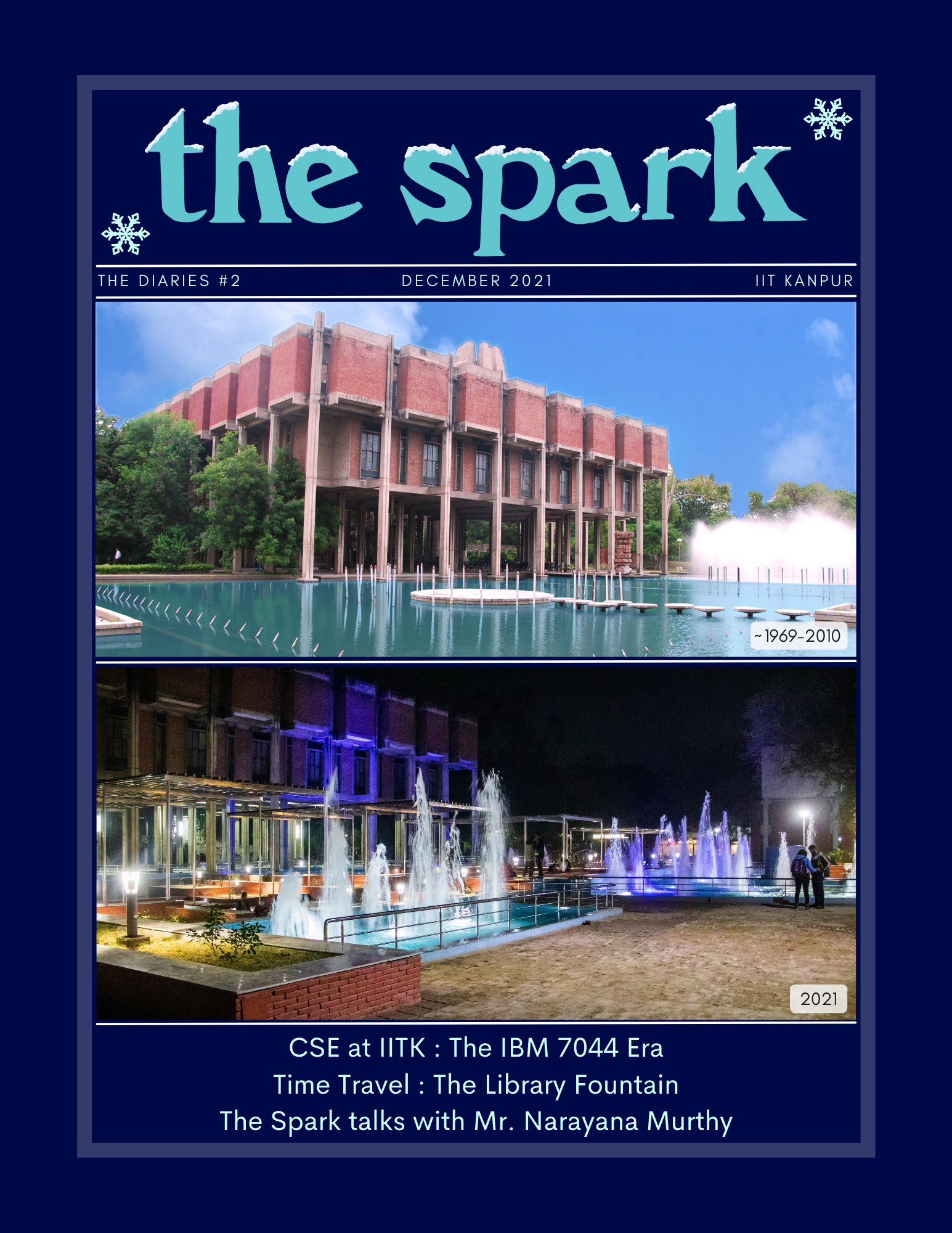
The Spark
December 2021
| Contents | Page |
|---|---|
|
Editorial - CSE at IITK, the IBM-7044 era |
|
|
Your Letters |
|
|
Bouquets or Brickbats… we would love to hear back from you! |
|
|
CSE: The Early Days |
|
|
Professor Rajaraman's anecdotes related to the IBM 1620 and 7044 systems. |
|
|
Meet Gio Wiederhold |
|
|
An original KIAP Professor has stories to share on the experiences of the American Faculty. |
|
|
A Spark Interview with Mr. Narayana Murthy |
|
|
Mr. Murthy on his formative years at IITK, and the creation of Infosys. |
|
|
Time Travelling the Library Fountain |
|
Images and stories from 1965 through today, shared by alumni and current students. |
|
*Pages 1-32 refer to The Spark Diaries #1, October 2021.
Editors: Aseem Shukla, Shirish Joshi, Chilukuri Mohan
Members/Contributors: Aamir Khan, Aditya Raghav Trivedi, Alpna Singh, Ananya Priyadarshi, Animesh Singh, Anurag Dikshit, Arvind Kumar, Gauri Sharma, Girish Pant, Gyan Mehta, Himadri Roy, Himanshu Singh Gehlot, Kartik Gupta, Kaushal Chari, Krishnendu Paul, Manoti Agrawal, Navpreet Singh, Parikh Mani Baro, Pradip Parikh, Pranay Mehta, Raj Bhattarai, Raman Bhatia, Ravi Mishra,Sanjay Ayyangar, Sanjiva Prasad, Shakti Chaturvedi, Sri Gupta, Suresh Reginald, Utkarsh Gupta
Special Thanks to: Professors V. Rajaraman, Hari Sahasrabuddhe, Gio Wiederhold, and Ross Bassett, DORA Jayant Singh, Mr. Narayana Murthy, and the Huskey family
Views and opinions expressed in The Spark are those of the Editors and Contributors and not those of the Indian Institute of Technology Kanpur, unless specified otherwise.
34
Editorial
The Spark wishes its readers Greetings of the Season and Best Wishes for the New Year!
Our second issue continues the story of Computer Science education at IITK, focusing this time on the IBM-7044 era (1966-79). If you missed the first issue, it might be worth flipping through it to get the background events of the IBM-1620, where it all started (https://iitk.ac.in/dora/spark/Spark.pdf ).
The Library fountains came back to life at the start of November, perfectly in time for the Institute Foundation Day and the Diwali celebrations. Our photo feature takes you through a time journey using images shared by many alumni, members of our Facebook group ‘This Bit of That IITK’. This story has truly been a team effort, written in bits over the past few years!
Special thanks to Mr. Narayana Murthy and Professors Gio Wiederhold and V. Rajaraman who took time out from their busy schedules to talk to us and help us compile some fascinating stories.
Thanks also to everyone who wrote back to us with their comments and feedback. We always love to hear from you and will try to publish as many of your letters as possible. You can reach us via email at spark@iitk.ac.in; or if you are on Facebook, post directly in our group ‘This Bit of That IITK’.
Food for thought: IITK was the first away-from-home experience for many of us, and an abrupt exposure to living a life of relative freedom, bound only by class timings, homework deadlines and dining hours. Looking back to those days, what do you feel would have made your IITK experience better? Write to us and share your thoughts.
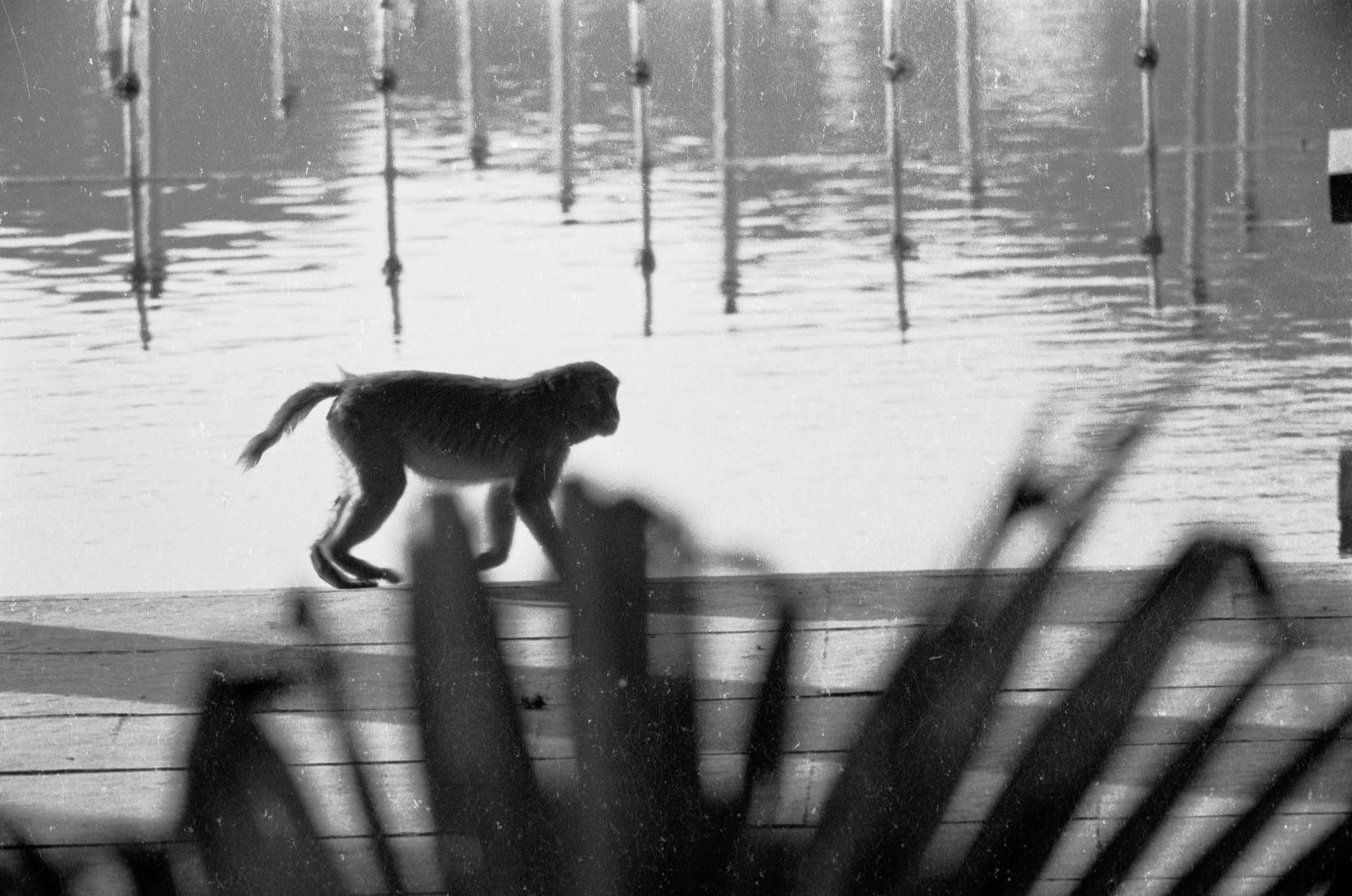
A contemplative walk around the fountain, perhaps after attending one of those open-air Philosophy lectures under the Library.
Picture Credit: Shirish Joshi, 1977
35
Letters to the Editors
Thank You!
I am thankful to the dedicated SPARK editorial team which brought back old Memories of the Building of the CS Department. It was a timely Deepawali Gift to all IITK alumni who spent their time at IITK.
I am sure there are other departments where students, staff and faculty also contributed in establishing the Department and graduating students who helped in Technology Development and Nation Building. I wish some of the Spark team members can bring up issues of other Departments’ History as well.
Thank you once again for keeping all of us informed about how IITK contributed in all sectors of Engineering Science.
Subhash Bhatia
Ex Faculty and IITK Alumnus
ChE Department
Thank you, Professor Bhatia. We still remember your Chemical Computations class, and still use your layout for converting units! Anyone who saw that probably never stopped using it! We will try our best to cover as many stories as possible.
Arrival at Hall I, July 1963
The story of the IBM-1620 being brought to the campus on a ‘bullock-cart’ through a flooded road rekindled some old memories. When I arrived at Hall 1, it was monsoon season and raining. There was no regular bus service from Kalyanpur to the hostel, so the last bit was on a rickshaw, plying the GT Road.
No one was around to greet freshmen; the rain and wet kept most students confined to their rooms. But I do recollect that a good 4”-8” of a ‘lake’ surrounded Hall 1. The structure was water-logged and I had to jump from the rickshaw, onto the entry-level concrete corridor. Of course, the corridor was an open-air breezeway, just columns, no walls or barriers.
Well, this wet welcome is still a fond memory from 1963. Maybe the most auspicious sign was a fresh water snake swimming in the monsoon lake. It was a lucky sign from Shiva and portended an easy passage through the next five years of academic learning because I was able to cross all barriers and obtain a valued IIT/K education!
Rajeev Bhargava
BTech, ME, 1963-68
Editor Spark, 1965-68
36

We couldn’t find a picture of the water-logged Hall I from 1963, but this is how it looked after the rains, with some improvement in drainage, a year or two later.
Picture Credit: Reminiscences – the 35-year Reunion Presentation of the Third Batch (1962-67), 2002
From a Founding Editor
An Excellent initiative! Really enjoyed reading it. Congratulations Ravi(Sethi)on a great piece.
All of us who started “Spark” are indebted to the current team for resurrecting the experience for us again! It does take me back in time some 55 years, when we were all starry eyed ingenus on campus!
I do remember the many times we had to even stay back in town as we sometimes had to set the pages to speed up the issue in a small dingy room at the publishers’. We didn’t realise then that what we were doing was creating a “startup” and the small sums of monies we took from some of our seniors were “angel investments”. And it took us some time to get our business model right. We tried for some time to run it on subscriptions but eventually learnt that it was not sustainable and got the ads model right! I also remember the parties we would do in town to celebrate and blow up our surpluses, once we turned profitable!! We rotated the editor position with Shiv (Sahai Mathur)being the first and then Ravi (Sethi), Rajeev(Bhargava),Ashok (Pasricha) and I took turns. Lalit Kapoor was fantastic as the Photography editor! He has now turned a health guru and lives in California.
Saurabh Srivastava
BTech, ME, 1963-68
Founding Editor, Spark, 1965-68
Padma Shri, 2016 and Distinguished Alumnus IITK, 1999
Member, IITK Board of Governors, 2021
37
The Huskey Family: A Few Memories of IIT Kanpur
My brother, Doug, forwarded the October 2021 issue of The Spark to me. When I read it, I was filled with nostalgia and pride. It was wonderful to see the photos! Fun to read about people I remembered from my childhood. I am proud that my parents put so much importance on education and that the love of education really drove a lot of their work. Both my parents were the first ones in their families to go to college.
An Sing, Linda and a Rickshaw-Walla, Kanpur, 1963-64
I was 5 years old when we moved to Kanpur in 1963 for one year. We had a wonderful cook, An Sing, who made the best nimbu pani. My brother, Doug, and I loved it! Doug and I went to the Methodist School there. My mother volunteered in the library at the school, and sometimes I would join her at lunch time. I remember attending the Methodist Church and its ceiling seemed so high and the building was very airy. Occasionally, birds would fly about inside the church, which I enjoyed.
38
Good-bye IITK! We shall return! Velma, Harry, Linda and Doug at the departure at Kanpur Central, taking the train back to Delhi, July 1964
We returned in 1971 when I was in 7th grade. This time my family lived on the IIT Kanpur campus in faculty housing. I was able to walk to the Central School on campus which I attended. One of my favorite memories was when some students of my father's came to the house on Holi and threw colour on him! Although my parents knew about the festival, I think my father was surprised! I thought it was hilarious!
In 1983 I returned to India to teach at Woodstock School in Mussoorie. I taught high school math there for several years and my parents enjoyed coming to visit! I also had the pleasure of visiting Dr. and Mrs. Rajaraman in Bangalore during that time!
Great memories!
Linda Huskey Retterath
Santa Clara, California
39
CSE at IITK – Some Recollections from those Early Days
V. Rajaraman (Professor, CSE IITK, 1963-82)
The IBM 1620 was the first computer to be installed at IIT/Kanpur. It was a gift from the Kanpur Indo-American Program (KIAP) and arrived in July 1963. The corner room in the Western Labs was earmarked for its installation. When the computer came on a bullock cart and unloaded, we found that the door leading to the computer room was not broad enough to move it into the room. The wall at the far-end was broken and the computer was moved into the room which already had a false floor, false roof, air-conditioning etc. Professors Harry Huskey, Forman Acton, and Irving Rabinowitz had come earlier to help run the computer. The computer was installed by Indian IBM customer engineers who had been trained for this purpose. IBM 1620 was the first computer with a FORTRAN compiler to be installed in India. No other IIT had a computer in 1963.
I started teaching TA 306, the first course in computer programming in 1964 on the 1620. The computer had 60,000 digits of memory and did decimal arithmetic by looking up an arithmetic table stored in its memory. Then IBM 1620’s informal name was CADET and people joked that it stood for “Can’t Add; Doesn’t Even Try!” The input used decks of punched cards. The output was also a deck of punched cards that were printed off-line using an accounting machine as a printer. Programming was done using FORGO, a version of FORTRAN II.

The IBM 1620 at IIT/Kanpur. R.N. Basu is mounting a tape. IBM Engineer Hinduja is standing in front of the console. M.N. Misra is operating the console typewriter Source: IIT Kanpur 1965 Convocation Publication, IITK and CMU Archives.
Students wrote their program, went to a card punch, punched the program, assembled the cards as a deck and submitted the deck to the operator. The operator collected all the decks from the students, made a batch of programs, and fed it to IBM 1620. The computer ran the programs and the results were punched on cards. Students collected their results and printed them, only to find that the result was an error message saying missing comma in line number 7! After correction, the deck was re-submitted. Hopefully, there were no more errors. Else, the cycle was repeated till the results came through.
40
Finally, if there were no logical errors in the program, the answer was correct. Most students had to go through three rounds of submitting decks, debugging, re-punching, and re-submitting, before they got the correct answer, even for a simple program such as finding the largest of 10 numbers. At the end of the first laboratory class a student came to me and innocently said: Sir, you said our computer is a wonderful machine that will reduce the work I have to do to solve problems. Now I don’t know whether I am working for the computer or the computer is working for me!
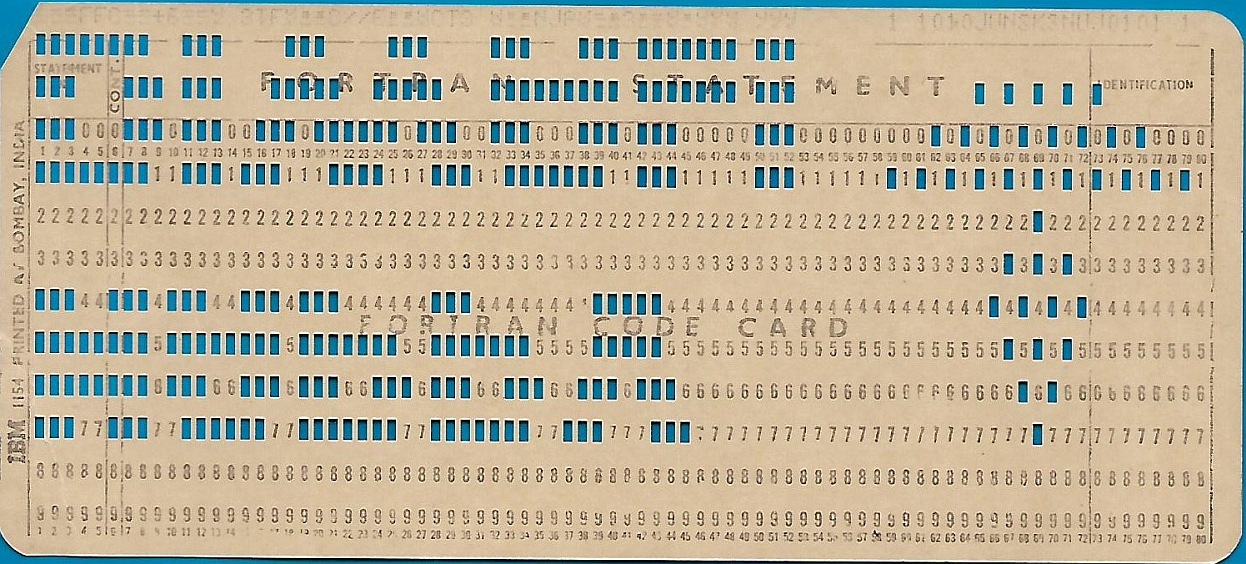
An IBM FORTRAN Code card. This one has been creatively punched, but it would have definitely given an error if fed through the reader! Shared by Pradip Parikh (BT, ME, 1975-80)
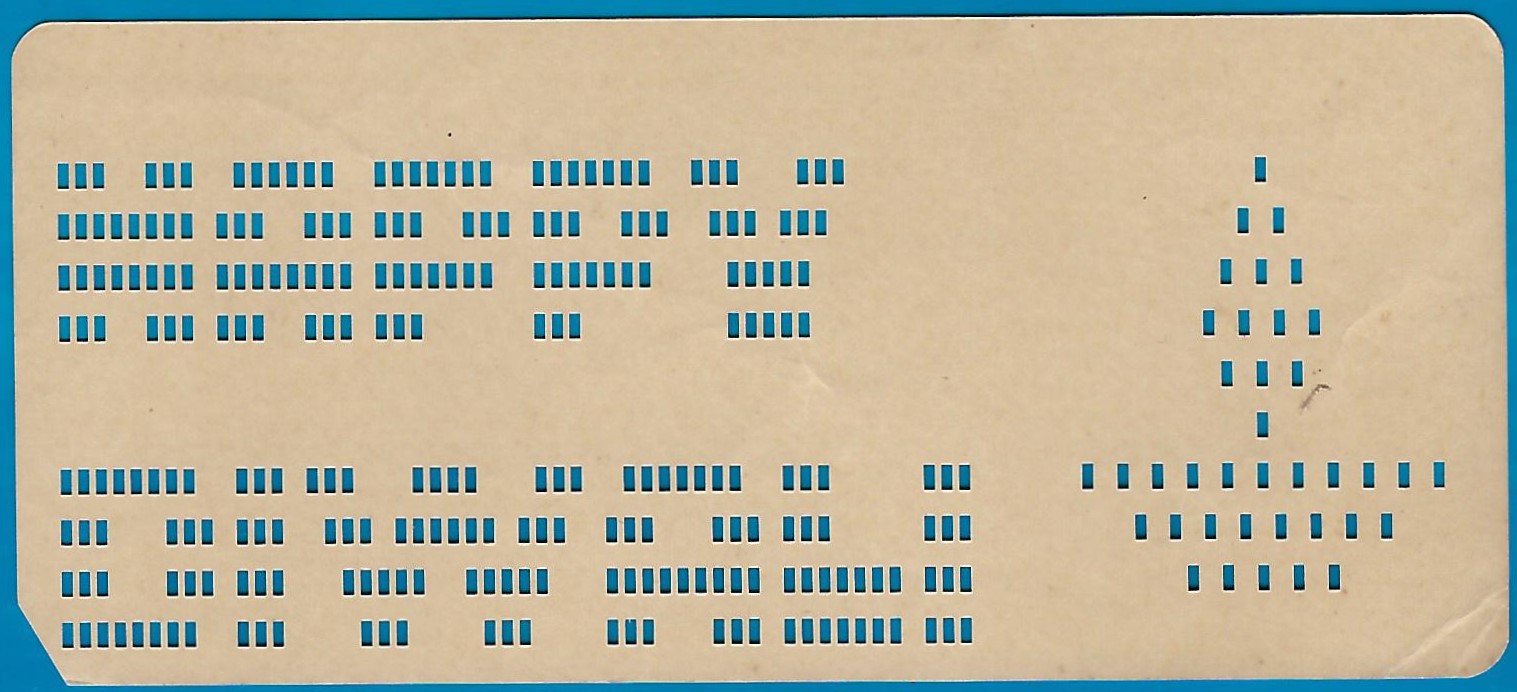
By 1965, the 1620 was running 24 hours a day, 7 days a week and was saturated. Waiting time to get results from the computer was becoming too long and IIT/Kanpur started looking for a bigger computer. KIAP did not have a budget allocation to buy a larger computer and we had to find our own resources to make this purchase. Besides this, getting foreign exchange to buy computers was difficult.
Meanwhile, the Tata Institute of Fundamental Research (TIFR) in Bombay was allocated funds by the Government of India to buy a large mainframe computer. IBM was very confident that it would get the order from TIFR and had quoted an IBM 7044. However, TIFR decided to buy a CDC 3600 from Control Data Corporation instead and IBM was left holding an unsold 7044.
When IBM learnt that we were planning to buy a larger computer, it approached us with a proposal to sell the IBM 7044. The 7044 was a mainframe computer with 32 Kilo words (36 bits per word) main memory, 4 tape drives, a fast CPU, and I/O units, but it was already being phased out in the US by IBM and succeeded by the IBM 360 series. Gio Wiederhold, a visiting KIAP Professor, was given the task of negotiating with IBM and getting a unit with the latest upgrades, to ensure that it lasted us for a while. The normal practice of IBM was to quote the price of imported computers in US Dollars. We told IBM our difficulty in getting foreign exchange. IBM, after consultation with their management, offered to sell the machine for Rs.60 Lakhs after giving a 60% educational discount.
41
IIT/Kanpur, however, did not have Rs. 60 Lakhs in its budget which was a huge amount in 1965. After further discussions, IBM agreed to receive Rs. 60 Lakhs in five installments of Rs.12 Lakhs each year. This offer was given in writing by one of the sales managers of IBM India in early 1966. This offer was satisfactory. However, the new computer centre building was not ready and there was no space to put the huge 7044 in the Western Laboratory. IIT/ Kanpur allocated Rs.12 lakhs to be paid in the financial year 1966-67. The 7044 was to be delivered in the later part of 1966.
We then received a shock. The Rupee was devalued on 6 June 1966 from Rs. 4.76 to a dollar to Rs.7.50 to a dollar. IBM India reneged and told us that the deal was off. Prof. Forman Acton of Princeton University, who was a member of the first American team that supervised the installation of IBM 1620, had stayed in contact with IITK. We told him about our problem with IBM. He immediately shot off a letter, in his own inimitable style, to one of the senior Vice-Presidents of IBM in the USA (who incidentally had been Acton’s student at Princeton) that what IBM India was doing was unethical and they could not go back on a written commitment. Acton got a reply that IBM would stand by its obligations. The IBM India sales manager came back and agreed to sell IBM 7044 as per the original agreement. The 7044 was delivered in mid-July and became operational in September 1966.

Professor Forman Acton (Princeton University) was part of the original team that installed the IBM-1620 in 1963-64. He stayed in contact with IITK and returned for another semester-long visit in August 1967. Picture is from the IITK archives.
Use of IBM 7044 as a stand-alone computer was inefficient as Input/Output was too slow compared to its processing speed. An IBM 1401 was required as an Input/Output computer. The 1401 read punched cards input and stored the program/data on a tape. This tape was read by IBM 7044 and the computed result was written on another tape. This was read by the IBM 1401 and printed on a high-speed line printer. The 1401 was made in India by IBM and we bought it the next year. It had 4 Tape drives, 5 Disk drives (2MB/drive), a card reader, and a high-speed line printer. It cost around Rs.35 Lakhs.
The IBM 1620 was moved from the Western Lab to the New Computer Centre Building after 7044/1401 started working in 1967. Eventually, it was sold to Steel Authority of India R&D Division, Ranchi around 1970. Dr. S.C. Mehta who was on the faculty at IIT/K joined SAIL R&D and was using it in their research.
The IBM 7044 and IBM 1401 were the main computer systems at IIT/Kanpur from 1966 till the DEC-1090 arrived in 1979. IIT/Kanpur was able to sell these computers by auction, a month before the DEC-1090 arrived, for Rs. 45 Lakhs. How we did it is another story!
42
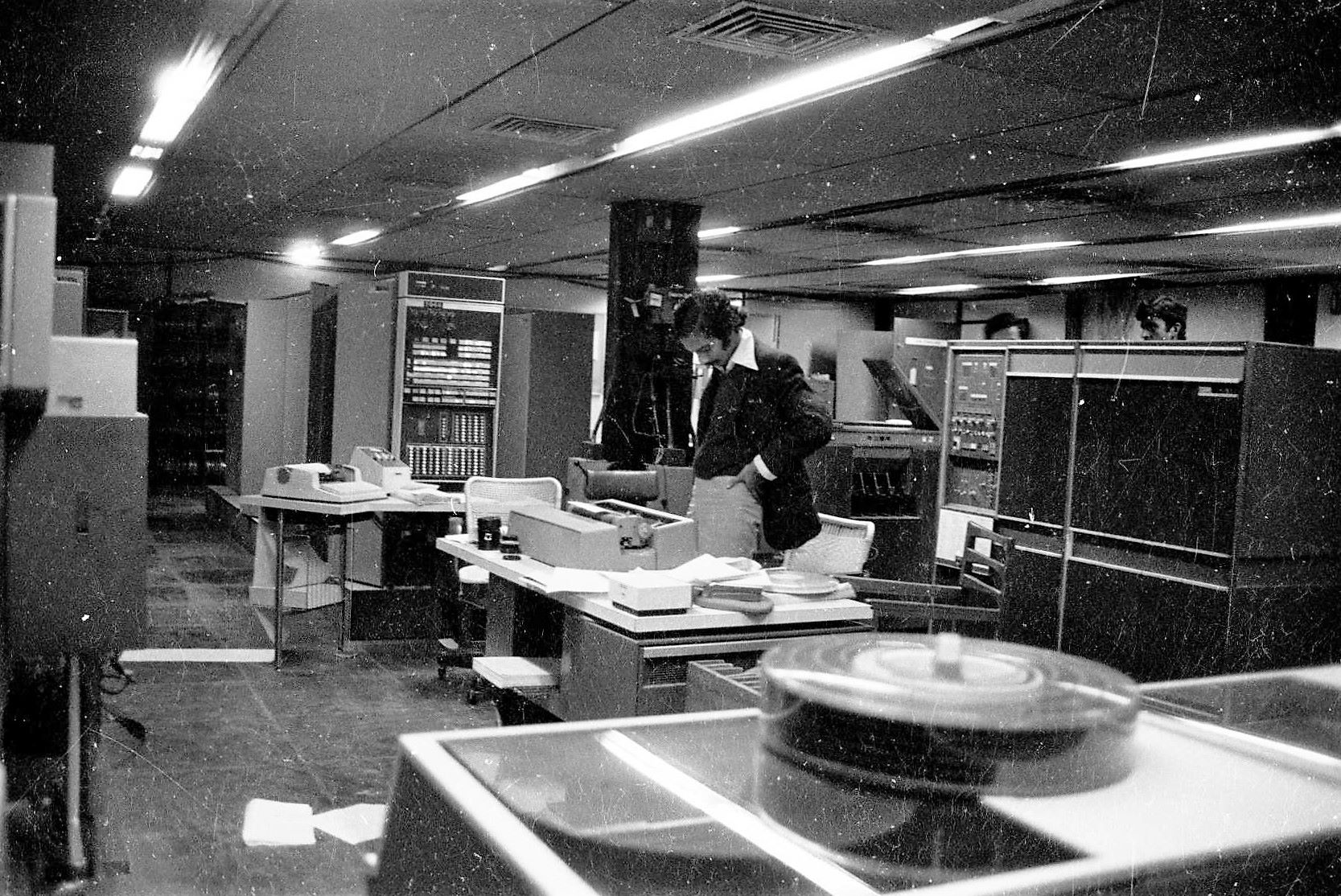
The IITK Computer Room, circa 1977. The IBM-7044 is visible in the back, and the 1401 on the right. The student in the room is Prasanna Mulgaonkar, BT, 1974-79.
Picture Credit: Shirish Joshi.
About the Author:
Professor Vaidyeswaran Rajaraman obtained his BSc (Hon) in Physics from St. Stephen's College, Delhi in 1952 and a Diploma of IISc (Electrical Communication Engineering) in 1955. Subsequently, at IISc he designed and constructed non-linear units for an analogue computer and applied it for solving a number of engineering problems. He went on to get his SM degree in Electrical Engineering from MIT in 1959, and then his PhD on adaptive control systems from University of Wisconsin – Madison in 1961.
In 1962 he returned to India, and joined the Electrical Engineering faculty at IIT Kanpur where he helped establish the M Tech program with Computer Science as an option in 1965, the first time the subject was offered as an academic discipline in India. Later, he helped introduce a doctoral program, and a group led by him pioneered the use of decision tables in development, debugging, and optimization of complex computer programs. He initiated the first BTech program at IITK in 1978.
Professor Rajaraman served as the first Head of the CSE Department at IITK. He was at IITK through 1982, after which he moved back to IISc, Bangalore. Among his many distinctions, he is a recipient of the Padma Bhushan, the Shanti Swarup Bhatnagar Prize, IISc Distinguished Alumnus Award, and Lifetime Achievement Award by the Indian National Academy of Engineering, Computer Society of India and the Systems Society of India. IITK awarded him an honorary DSc.
Dr and Mrs Rajaraman with their gardener and two students.
Photo Credit: Shirish Joshi
43
Student-teacher interaction on campus was one of the great ‘freedoms’ that everybody liked. The idea was that the person who knew a subject was the teacher, and the one learning was the student. Thus, in the classroom, the professor was the teacher, and the students were, well, students. But elsewhere, such as in the Drama Society, a student director might be the one teaching a professor how to play a particular role. This role reversal, or role equality, made a great difference in the student-teacher interactions outside the classroom, making them much more open and relaxed. Dr. Rajaraman was a great teacher, both then and now. But everyone was welcome to visit his house, where, during Holi, Dr. and Mrs. R would keep a thali loaded with Laddoos ready for the hungry hordes.
The Classic Text Books
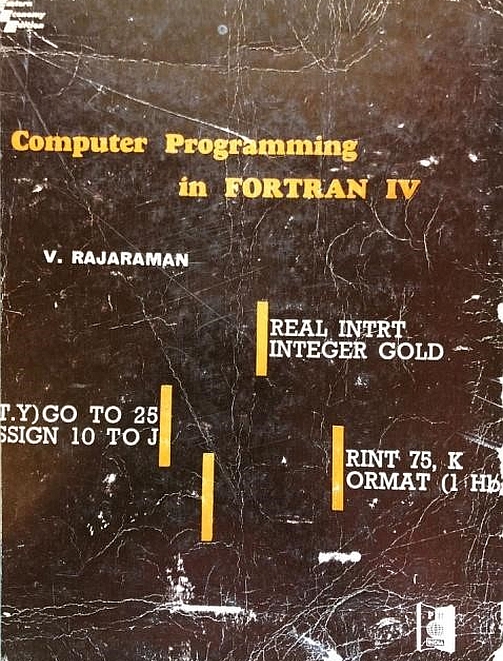
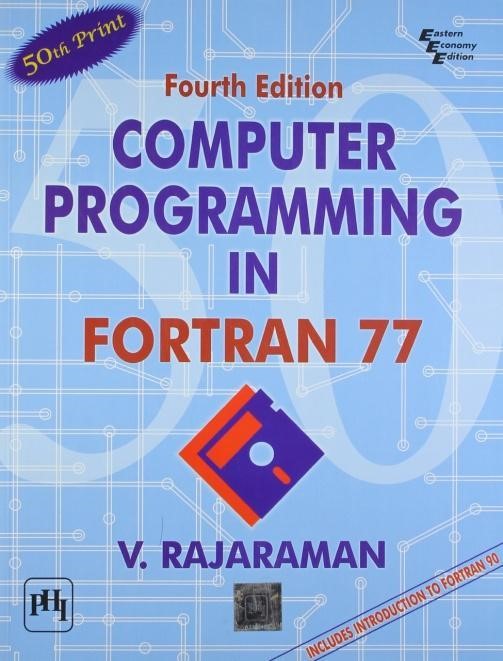
This classic textbook was used for TA-306 at IITK. All students used this for their FORTRAN programming classes, until we switched to Pascal in 1980. On the left is an original from 1973, saved by Raj Bhattarai (1971-76). Now into its 53rd Printing, the one on the right is a more recent version, available on Amazon.
Three of Professor Rajaraman’s books originated from cyclostyled notes distributed to the 10-day intensive course participants: Computer Programming, Numerical Methods, and Computer Organization. They were probably his first three textbooks on Computer Science in India.
The first book naturally addressed FORTRAN II, for which we had a compiler on the 1620. Later on, as new versions of FORTRAN were released, he kept updating his book. The cover on the left indicates IV, so it is probably his second book on Fortran from the IBM 7044 era.
The larger-than-usual format stayed with Rajaraman's books for a long time. He would type them on an electric typewriter and send them camera-ready to Prentice-Hall, so as to not need multiple cycles of proofreading and finally errata - standard features of book publishing in pre-DTP days.
(shared by Professor Hari Sahasrabuddhe)
44
Meet Gio Wiederhold
Shirish Joshi (BT, ChE, 1973-78)
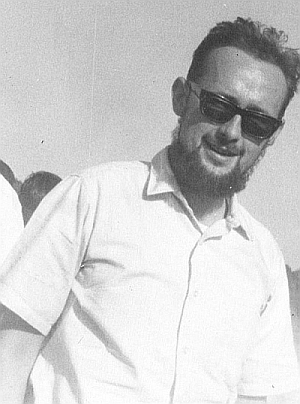
Gio Wiederhold, an original KIAP professor, was on campus in 1964-65. Then in his late twenties, and one of the youngest KIAP participants, he lived in Vishnupuri near Parvati Bagla Road in Kanpur and commuted to the Institute in the station wagons, which were used to pick up and drop off KIAP staff that could not be housed on campus. He was there to teach CS courses, take care of the Computer Center with its 1620, and start the procurement process for the IBM 7044 machine. In that one year, he managed to travel across the country, had a lot of adventures, took quite a few photos, and stored up enough memories to last a lifetime. Most of us are familiar with the collection of KIAP era pictures he assembled, now readily available at his Stanford site, and republished almost everywhere.
Today, Gio is Professor (Emeritus) of Computer Science, Medicine, and Electrical Engineering at Stanford. He is still very active, still loves Indian food, and remains in touch with a lot of the original program people. Just to get an idea of how active Gio still is, here he is, in his study. Two huge monitors (one with a photo of a 1964 KIAP event), plus a third monitor on the bookshelf behind in case these two are not enough. Plus, stacks and stacks of shelves full of books.
Over four hours of conversation he retold a lot of stories. Here are some of them!

45
Night Flights to Bombay, or, How IITK got its IBM 7044 Computer
IITK under construction was an adventurous place. Buildings going up everywhere, professors creating courses, computers being delivered on bullock carts.
Among all the chaos was the plan to get another computer system – bigger than the IBM 1620, that is.
Because the 1620 was already there, but inadequate for growth and idiosyncratic in terms of design, the decision was to get an IBM 7044 with a more conventional architecture. Most American universities had one, so collaboration would be easy, the IBM guys on site could maintain it, and so on. Gio Wiederhold, the computer whiz, was charged with the actual acquisition process.
Gio had an interesting background, having started out with vacuum-tube computers in 1958. That meant, in part, that he knew more about computer hardware than most computer-savvy people of that time, though his youthful face didn’t give you the slightest inkling. He knew about the newest I/O devices, storage, tape drives, printers, you name it. That was rather unfortunate for IBM, whose India Sales Team in Bombay had not heard of Gio.
However, in true salesmanship fashion, IBM Bombay could hassle Gio and thus try to weaken his negotiating ability. They would call him for negotiation meetings at a days’ notice, with some excuse about someone from IBM HQ being available for that day only. They knew fully-well that there was no way anyone from Kanpur could show up the next morning for a 10AM meeting. There were no flights from Kanpur, and the Lucknow-Delhi-Bombay flight was in the afternoon, and always fully booked. No way he could make those morning meetings, so they expected he would ask for delays, which would get him obliged to them, giving them an edge. Such are negotiation tactics.
But they didn’t know Gio.
Small side-story here. A little-known fact about the Indian Postal Service was that airmail distribution in India to and from major cities was on a nightly hub-and-spoke system that was run by Indian Airlines. Late at night, Indian Airlines aircraft took off from major cities loaded with sacks of mail. They all converged at Nagpur, where the bags were re-distributed, and the aircraft headed back with mail that was to be delivered to their city. These were cargo flights, not intended for passengers.
But Gio knew about those flights. Don’t ask how. He would take a campus car, drive to Lucknow, and get onto the night flight to Nagpur, right among those sacks of mail. The plane carried the pilot, the co-pilot, sacks of mail, and Gio. They all knew him, they knew about IITK, and there was never any trouble.
Off they would fly to Nagpur, Gio hopping off one Avro and getting into the next while the mail was sorted and reloaded from one aircraft to another. He would be at Santa Cruz airport in Bombay early the next morning. A quick run to the hotel at Juhu to freshen up, and off to the meeting with IBM.
Poor IBM. In all the meetings that they had with Gio, they never figured out how he got there so fast. As a consequence, their negotiation and sales skills failed to give them an advantage, resulting, in part, in IITK receiving a first-class 7044 system on par with the ones being installed at US universities in the sixties, and IITK having a very good machine well into the seventies.
46

The tape drives were a major point of contention. IBM was trying to pass through their existing stock of Low-Density drives, stating that they would be better for Indian conditions, but Gio knew that High Density drives were available and had error-correction, which actually made them more reliable for dusty environments. Gio specced out exactly what he wanted, and that is how IITK still had a very good 7044/1401 based computer center all the way into the mid-1970s. Photo Credit: Shirish Joshi, 1977; model Vineet Singh, EE, 1974-1979.
Cadillacs in Coonoor
One little-known fact about the birth of IITK was the difficulty that the program faced in getting Program Leaders and Professors to come from the USA to IITK. The issue was that if they stepped away from their home base where all the newest developments were happening, they would soon fall behind. Plus, for faculty, there was the issue of tenure, seniority, paper publication, research, and all kinds of complications for family relocation.
Thus, creative ways had to be dreamed up to incentivize people to move. In addition to the more formal ‘temporary relocation’ efforts used by the administration, spouses who wanted to go but were held back because their partners were hesitant, used creative methods. This was very much the case with the admin head honcho himself, Jerry Vielehr.
Jerry Vielehr was the Administrative Officer of the overall program. That meant, among other things, overall responsibility for constructing the campus. Big job. Jerry’s wife Patricia was very social. Jerry loved his beer. While Jerry was ensuring that the campus was being built to specification, he didn’t get out very much. On one of their return visits to the U.S. Jerry realized that he had been too busy to see much of India. Patricia figured out that he could make such a sightseeing trip later, and arranged to enable that, with his own special car. To do that, she reached out to General Motors to modify a fancy car. (Patricia was the daughter of a New Jersey Governor, so well connected).
47
It had to be a convertible to keep cool breezes blowing, had to run on Indian roads using Indian-grade fuel (which meant a variable quality of kerosene/diesel/petrol mixtures). The most important customization: it had to have a refrigerator to keep Jerry’s beer cold.
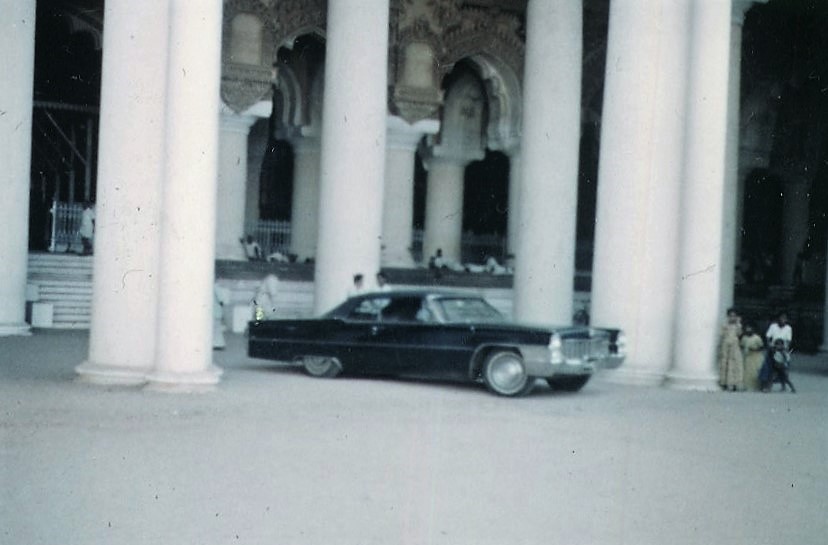
Jerry Vielehr's Cadillac at the Tanjore Palace. It was over 24 feet long
Well, the custom-car was built, then loaded on a ship and delivered to the Bombay docks in the middle of June 1965. Gio Wiederhold, among the younger and more enterprising KIAP people on campus, went off to Bombay to collect it from the dockyard and get it ready.
Why Gio? We don’t know for sure, but we do know that he had figured out how to work the system. He could bring in computers from the US that arrived with no documentation; he got rides in Indian Airlines planes that normally didn’t carry passengers, and so, getting the car out from Mazgaon Docks without any customs delays was a piece of cake. (You have to remember that getting ‘any’ car imported into India those days was a major miracle).
When the car was in hand, Jerry and Gio travelled much of South and Central India, driving down the west coast (Goa, Mysore, Ooty, then down to Cape Comorin, and up the east coast to Tirupati, Chennai, Hyderabad, thence back via Bhopal).
There were several challenges when driving a Cadillac in India. Cadillacs are gas guzzlers, and this one was an especially thirsty car, having to haul and run the built-in refrigerator as well as the car itself. One day, they pulled up at a petrol station in one of the many villages. The car was followed by a large group of the local boys who were amazed at its size and shape and called it a boat car! The rural petrol bunk was an old one; the pump was operated manually with a hand-crank. Jerry had the engine running to keep the A/C going, while filling petrol. After many minutes of the hand-cranking, the petrol bunk operator finally gave up and told Jerry to switch off the engine and said, "Sir your car is gaining on my pump and it will never get filled!".
48
Another major challenge they had to deal with was handling a car of that size on narrow Indian roads. Indian cars at that time were the Hindustan Ambassador, the Fiat 1100 and the Standard Herald, none more than 14-feet long and five feet wide. The Cadillac cruiser was over 24 feet long, more than six feet across, and over 4000 lbs. When in a city, they had to be careful to not get stuck in narrow lanes that had been designed 500 years back for bullock carts. When crossing rivers that didn’t have a bridge, simply getting the car onto the ferry was an adventure.
Having a limited-slip differential gave the Cadillac some advantage on slippery roads, even when Jeeps would have two wheels spinning on a muddy side. But crossing the Narmada river at Hoshangabad was a memorable event. The car had to be gingerly driven down to the riverbank, then up rickety planks to the ferry itself. The ferry, sized to haul an Ambassador or a Jeep, was too short for the Caddy, and the crossing would happen with the rear wheels right on the back end of the ferry, with the rest of the car hanging out over the water.

On this occasion, the tires slipped off the planks while driving the car up onto the ferry. The usual method when a Fiat slipped off was to round up the local people, pick up the car and put it back on.
But this behemoth weighed nearly two tons, and there were not enough people to do the heavy lifting, so poles and levers had to be used (which didn’t do the bodywork any good, but that is another story). With enthusiastic yells and ‘Dum Lagao Haissa!’ providing the rhythm, the car was shoved onto the ferry.
49
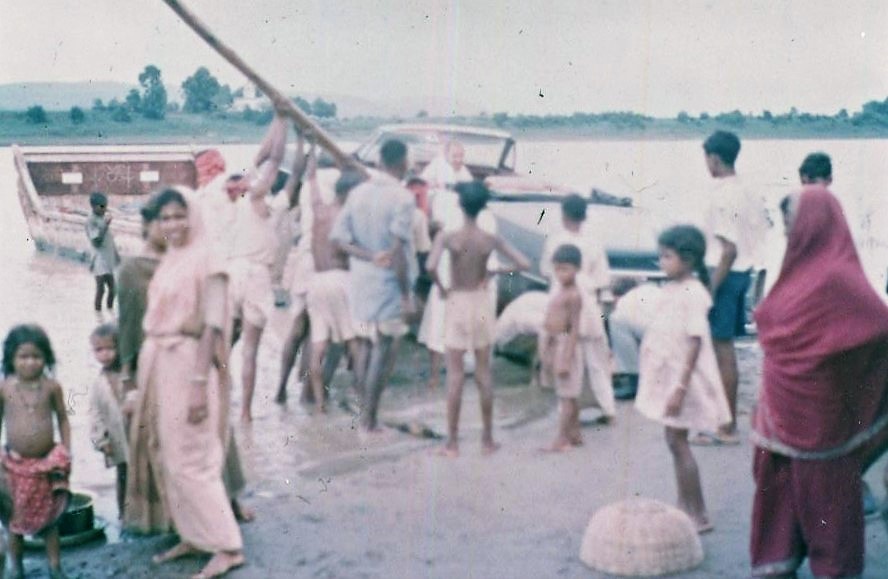
The Caddy, slightly the worse for wear, did the entire trip without any problems, although its fuel tank had lost some capacity.
After this trip, the car had to be exported and was eventually sold to someone in Bhutan. Jerry Vielehr returned to the US after completing a seven-year KIAP stint in 1969, probably the longest among all the American faculty and officials.
About the Contributors
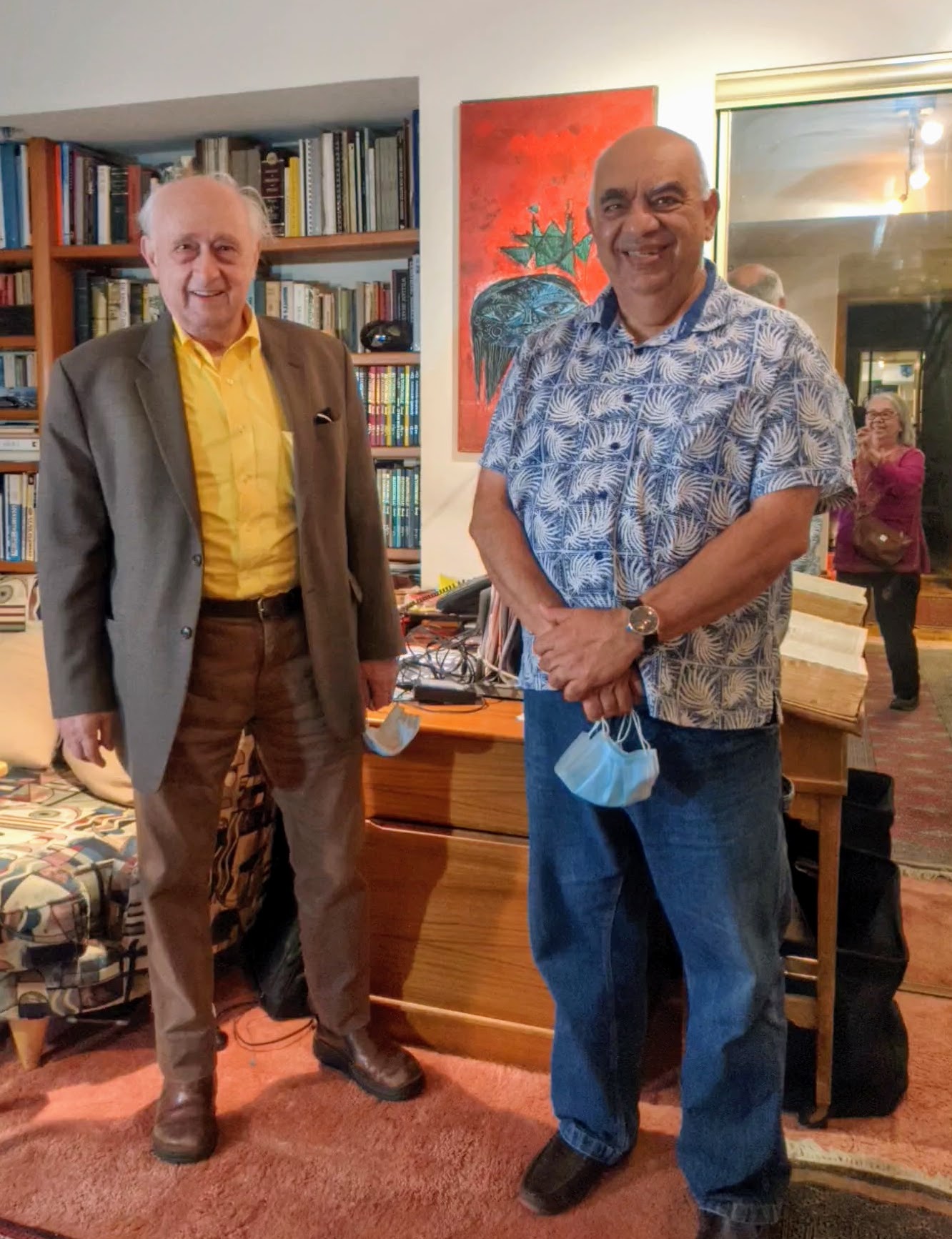
These stories were retold by Gio Wiederhold in a meeting with Shirish Joshi, at his Bay Area home in July 2021. Gio’s love for India and IITK remains undiminished. Shirish had reached Gio’s residence expecting an hour-long conversation. Four hours later, our Spark correspondent had to tear himself away because it was late, and 'he' was getting tired.
Credits: All pictures have been provided by Gio Wiederhold, unless indicated otherwise
50
A Spark Interview with Mr. Narayana Murthy

In August 2021, the Spark interviewed Mr. Narayana Murthy, the founder of Infosys Limited, on his formative years at the Indian Institute of Technology – Kanpur (IITK). The transcript of this conversation follows. The Spark team was represented by alumni Shirish Joshi and Aseem Shukla, DORA Jayant Singh, and Content Writer Gauri Sharma from the DORA Office.
Spark: Good evening Mr. Murthy. Thank you for your time in talking to us today. Our conversation will focus on IITK, your arrival to the campus, your experiences there, and your career upon graduation. Your story is an inspiration for the students and alumni of IITK, who look up to you and see themselves achieving their own version of success as you did. With this in mind we have some questions on the topics we would like to discuss.
Coming to IITK
Spark: You come from a traditional middle-class family. Tell us about your memories of your childhood in Mysore.
NM: Well, let me first thank every one of you on this call for this opportunity to interact with you.
I came from a lower middle-class family. My father was, for most of his career, a high school teacher who taught English, Physics and Mathematics. We were eight children - three brothers and five sisters. My grandmother lived with us. Therefore, when I say that eleven people depended on the salary of a high school teacher, my economic background becomes very clear!
While we were poor, we were rich in culture and values. There was considerable focus on aspirations, achievement, studies, and good behavior. My father believed that performance was the only escape velocity we had from the orbit of poverty we were trapped in.
I did reasonably well in my studies. I obtained the fourth rank in the state in my SSLC examination in 1961. I got the third rank in the state in my PUC examination in 1962. There were only two universities in the state at that time.
I could not go to IIT for my undergraduate education. My father would have had to foot the bill or take a loan for the tuition fees and hostel expenses. He just could not afford to do that with eight children. I did get the national scholarship. But, those days, the scholarship money would be disbursed at the end of the year which would have been too late. My father felt that it did not matter where I studied. The goal, for him, was for his children to do well in whatever they did. I decided to continue my engineering studies in Mysore while staying at home.
51
Spark: Can you recall any events that moved you to Engineering and possibly not Medicine (the other career of choice in those days)? And why did you want to do an M Tech?
NM: Those days, job opportunities were very few. Almost all reasonably competent students studied either Engineering or Medicine. I decided to pursue Engineering because I was not very comfortable with Medicine. I was uncomfortable with blood, cutting animals and all that. So, I joined the National Institute of Engineering (NIE) in Mysore. NIE had been founded in 1946 and was already a sixteen-year-old excellent institution with good teachers in 1962. Every year, I used to be one of the top two or three students in the university while at NIE. I chose Electrical Engineering because, those days, the toppers pursued Electrical Engineering (EE).
I was heavily influenced by a professor of mine at NIE. He taught me the basics of Control Systems which are based on Mathematics. I decided to apply to the Indian Institute of Science in Bangalore (IISc) for my graduate studies. Those days, Tata Institute (as IISc was known during that time) was ‘the’ place. Engineering students in Karnataka did not think there was any Indian higher educational institution for science and engineering better than that.
I joined the Tata Institute in July 1967. But I was not very comfortable with the choice of courses at IISc those days. (By 1972, when my wife joined IISc for her graduate studies in EE, the curriculum had changed significantly. It had become like the course requirements at IIT Kanpur.) But, in 1967, it was still old fashioned. After a month or so, I went to the head of the department and sought his permission to leave the programme since I had a different expectation of graduate studies.
I did not consult my parents. I just packed my bags and went home to Mysore from Bangalore. They were shocked.
Spark: Why IITK? And, why so far from Mysore? It would have been a long haul to go from Mysore to Kanpur. Train to Madras, another train to Jhansi, yet another train to Kanpur, and then a tempo to campus!
NM: When my father asked me what I would do, I told him that I had heard about an institute called IIT Kanpur (IITK) which was supported by nine top quality American universities. I told him that there would be lots of freedom for students to select whatever courses they wanted, apart from a small number of compulsory courses. I also told him that there would be the opportunity to learn from professors from top quality American Universities. I finally told him that I would look for a job in the Electricity Board in Karnataka if I failed to get into IITK. I was fortunate to be selected in the December 1967 batch. That is how I went to IITK. The train trips were another matter and were very interesting in themselves.
Spark: Well congratulations! That was quite a story! You went a long way! If you had joined the KSEB, maybe we would not be having any power issues! Do you remember the name of the Controls professor in Mysore?
NM: His name was Prof. Satyanarayana Rao. He is no more. He was the person who influenced me a lot. I learned two things in my undergraduate engineering course. The first was Mathematical Modeling and the second was Negative Feedback. I had never heard of that concept till then. Prof Rao explained to us how Negative Feedback brings stability to a system. I continued my interest in control systems at IITK. Prof. I G Sharma was the person that taught us Modern Control Theory and Optimal Control Theory at IITK. He was the one that we looked up to in this area. If I am not wrong, he left IITK for IISc in 1970 or 1971. He was an extraordinary professor!
52
Life at IITK
Spark: What did you think of your life at IITK, both in academics as well as student life? The way the curriculum was structured, the academic freedom, the approachable faculty, and overall informality, especially after the structured education in your UG days? A KIAP professor motivated you to change from Controls to IT. How did that happen? Who was he?
NM: The third semester was about to start in 1969. One Sunday, I was having breakfast in the mess (the dining hall) of Hall 5. A visiting professor from the US was sitting at the next table. He was there that morning since he had been invited for breakfast by a group of students. If my memory serves me right, he was either Prof. Wilhelm from Ohio State or Prof. Acton from Princeton. I could be completely wrong in my recollection. The professor was giving a brilliant expose on how computers would transform our lives in the future. His imagination was just unbelievable. I went and sat at his table with his permission, and I asked him if he could suggest three or four papers that I could read. He suggested some papers. I went to the Central Library after breakfast and read them. Monday morning, I went to Prof. I G Sharma and requested his permission to change my specialization to Computer Science (CS). Those days, you could graduate in EE and specialize in CS.
Prof. I G Sharma was a very open-minded and kind person. He asked me a few searching questions. He wanted to ascertain whether my infatuation with CS was a passing fad and whether I was flitting from one major to another. It looked like he was convinced of my genuine interest. So, he let me drop the Advanced Control Theory courses and take the Computer Science ones instead. And that is how I shifted to Computer Science at IITK.
Spark: We find it fascinating that a discussion in the Hall 5 mess opened doors to this opportunity and that professors interacted with the students in the mess and gave valuable advice.
NM: Yes, there was a lot of interaction with faculty. We also had some extraordinary student role models for us in the department. Muthu (Prof C R Muthu Krishnan) who was doing his Ph D in CS then was one such. There was another genius in Buddhe (Prof Hari Sahasrabuddhe). I did my master’s thesis with Prof Sahasrabuddhe.
My own role model was my classmate, Mohan Rao. He was extremely intelligent and, more importantly, he was very humble. He went to TELCO. Unfortunately, I lost touch with him. There were several bright students with me including Ganapathy, Jairam Murthy, Jamuar and S Ramakrishnan. Prof. Rajaraman was, of course, the head of the computer center and the head of the department. Prof Mahabala was an eloquent teacher. Prof Viswanathan was the master of everything he taught. Prof R N Biswas was our favorite with his deep subject matter expertise and unimaginable kindness.
Spark: It is remarkable that all these professors, who were so good, were also so accessible. You could go to them and there was very little in terms of hierarchy. If you have a professor sitting in the Hall 5 mess having breakfast, that itself tells you about what the environment was like. If you take the academics out of it, they were just people like you and me.
53
NM: There is no doubt about it. Almost every one of them, including senior people like Prof C N R Rao, was very accessible.
I knew Prof C N R Rao well because Kannada was the mother tongue for both of us, I would go to his house often. As hosts, his wife, Indumati, and he were very kind. There were quite a few Kannada speaking professors on campus, including Prof. Srinath, Prof. Ramachandra, Prof. Vasudev, Prof. Mahabala, Prof. Lakshmi Viswanathan, Prof. Kadambi and Prof. Muthana who was the Deputy Director then. Prof. Muthana became the Director later. There was a lot of informality on the campus.
Student Life, Maharishi Mahesh Yogi
Spark: So, you lived in Hall 5. Do you remember the wing / room number?
NM: I used to live in Hall 5. My room number was C-209.
Spark: Other than academics what else do you remember from Hall 5? You had aloo parathas on Sunday morning?
NM: Aloo parathas were the main attraction on Sundays. We looked forward to Sunday breakfast. How can I forget those?
The most memorable event of my stay in Hall 5 was when Mahesh Yogi visited us. Mahesh Yogi had become very famous in 1968 because the Beatles had adopted him as their guru. He came to IIT Kanpur in 1968 and gave a lecture on Transcendental Meditation (TM). It was in L-7 on a Saturday evening. At the end of his talk, he offered to initiate some students into TM in their hall of residence. There was a lottery. Hall 5 was chosen.
For most of the students, Saturday evenings were normally spent playing cards, sleeping at 2 am, and then getting up at 9:30 am to feast on aloo parathas. That Saturday, we just stayed up for the 5 am TM session by continuing to play cards through the night. We went straight to the Common Room (also used as the TV Room; we had closed circuit TV those days -- it was gifted by a KIAP university) at 5 am.
We trooped in and some of us were quite sleepy. Mahesh Yogi came in at 5 am sharp and sat down. He called us one by one. There were probably about 30 to 40 students. He asked me who my favorite God was. I played truant and said I did not play favorites with Gods! He told me that the TM exercise was to close my eyes and repeat the name of Ram non-stop till he asked me to stop. The TM exercise started after every student was initiated like I was.
After about 10 minutes, Mahesh Yogi asked us to stop our TM exercise. He asked one of the students to describe what he had felt while he was practicing TM. The student replied he felt fantastic, and that he totally forgot where he was. I must have been looking very sleepy. So, Maharishi pointed to me and asked me how I felt. I was mischievous and honest. I told Maharishi that I slept off. I did not tell him I was awake the whole night!
What Maharishi said in his reply astounded me and my friends. He said, ‘You are the only one who has learned the art of Transcendental Meditation!’ He even offered me free admission to the advanced course in TM at Rishikesh as a reward for being the best disciple of Maharishi from Hall 5!
Spark: Because you told him the truth, not what he wanted to hear!
NM: I do not know whether TM was supposed to induce sleep or not. The reality was I was very tired after being awake the whole night!
Spark: That would be Bridge we presume?
54
NM: Most played Bridge. Some played Teen Patti. My hostel room was like a Common Room. It was a meeting place for my friends. Many students would come. They would have bilateral games and discussions. They would behave as if it was their room. Hall 5 rooms were quite small. But, as a student, you do not need much space. What you need is the company of fun-loving young minds and hearts.

Credits: Sketched by Raman Bhatia (BT, ME, 1977-82)
Spark: How was the food in those days in the mess? When we were there in the 1970s and the 1980s it was quite bad. We used to bring our favorite pickles and ghee from home. How about you?
NM: Food quality was OK. It was a new experience for us from South India. We had to fight hard to get rice and sambhar at least twice a week. Let me tell you a story about the food crisis in Hall 5. Hall 5 had the unique experience of supplies being cut off from the Central Stores because either some students had not paid their monthly dues in time to the mess, or the funds had been mismanaged by the mess committee members. The result was that the Central Stores cut off supplies of rice, atta, vegetables, oil, and condiments. That left us with nothing to prepare food to eat. What was left in the mess kitchen was just a small mountain of mangoes. Some were ripe, and some were unripe. So, we had the unique experience of managing two days just eating mangoes!
Spark: Hall 5 probably had the best food in the 1970s, after the Girls Hostel. We were always trying to make friends there so that we could get invited over for dinner.
NM: During my time, the quality of food was clearly the best in Hall 4, and then, probably, in Hall 1. But the best food by a large margin in any institute of higher learning in India during those days was at IISc. Absolutely top quality! The joke among students of the sixties at IISc was that IISc was an institute attached to a high-quality mess, just like ASCI in Hyderabad (which had an excellent bar) was called an institute attached to a bar!
Spark: What other extra-curricular activities were popular? Did you watch movies in L-7? Did people go to the dhabas at the Transport Section and the Chungi, or dine at Chung Fa in the city?
55
NM: Yes, we used to have movies in L-7, but I did not know Hindi. Even today I do not know Hindi well enough. So, only those days when there was an English movie, we used to watch it in L-7. The quality of the projector and the quality of the sound system were not good. So, I would not say that it was a big attraction at that time. It may have become a much bigger thing later.
We used to go often to Chung Fa in the city. We enjoyed the Chinese food a lot. The graduate students did not participate in many games those days. Very few of us participated in extracurricular activities. Those facilities were almost exclusively for undergraduates. For some reason, there was a mindset divide between the graduate students and the undergraduate students those days. Graduate students were primarily focused on their studies. They were made fun of by undergraduates as Medhaks. I do not know why they called us so even today.
Director Kelkar introduced a novel scheme to bring undergraduate students and graduate students together. This pilot was started in Hall 5 in 1968. All the single rooms were allotted to graduate students, but the double rooms were allotted to two freshmen undergraduate students. I made good friends with several freshman undergraduates. They were very bright and lots of fun.
Hall 5 was very well designed. I enjoyed my stay there. We were the first occupants. It was new, and we had many choices for our rooms.
Personal Values
Spark: You have displayed a very adventurous streak in your personal life and risked family and personal freedom in your early adventures around the world. Where did you get this strong, independent streak from? Where else has it manifested itself? How do you see today’s kids striking out on their own?
NM: Rather than those esoteric words, let me speak about some interesting events that happened while I was at IITK.
Let me tell you about my Mysore-Kanpur-Mysore journey four times a year. I used to take a train from Mysore to Bangalore, wait a few hours, take the second train from Bangalore to Madras, wait several hours, take the third train to Jhansi, wait a few hours, and take the fourth train from Jhansi to Kanpur. The journey took about 36 hours. It was quite an adventure since I didn't even know any Hindi. But what impressed me much was the affection and care that the poor farmers and the rural people on the Jhansi-Kanpur passenger train showed us even at 3 am. Their desire to help students pursuing higher education was just extraordinary. They knew we were students going to Kanpur. They would make space for us to sleep on the bench, they would sit at the edge of the bench, and not disturb us at all. When I think about this sacrifice of our poor to help us, the students, get a good education and become better, I have a lump in my throat. I continue to be a compassionate capitalist even today, thanks to such wonderful memories of the kindness of the poor and rural folks in India.
When I joined IIT Kanpur I had heard that there were three IBM computers. One day, during the first week of my stay, I went with a friend to see these computers. One machine seemed busy, and it was making a lot of noise. Hollerith cards were going in and the machine was spewing out printed sheets. I must confess that I found it a little strange that electronic computers were making so much noise. That evening, at dinner with hostel mates in Hall 5, I discovered that I had been fooled and that I had only visited the printer room! I was at the receiving end of jokes for many months.
56

The ancillary equipment area in the Computer Centre which housed the printers and card readers. Visible here are the IBM 1311 drives that were used to transfer data from the IBM-1401 to the IBM-7044.
picture Credit: Shirish Joshi, 1977.
People used to do interesting things with those printers by punching a sequence of cards with specific letters so that you could get images to print on the line printers. My master’s thesis used that idea. It was titled, “Toroidal Structures in Picture Processing”.I used languages called LISP and SLIP and generated output using the IBM-407 printer. That was all the equipment we had for picture processing at IITK in 1968!
Spark: So, you had some fun there, even with your thesis!

An image of MAD magazine’s Alfred E. Neumann created on a line printer at IITK.
Credits: Sanjiva Prasad, Festival Souvenirs, 1982 and 1983.
57
Career
Spark: Tell us a little bit about the years after IIT Kanpur. You started your career conventionally, taking up a job at IIM-A. But something made you start Softronics. What encouraged you to start a private company? What learning experiences did it provide? How have your learnings at IITK contributed to your success and that of Infosys?
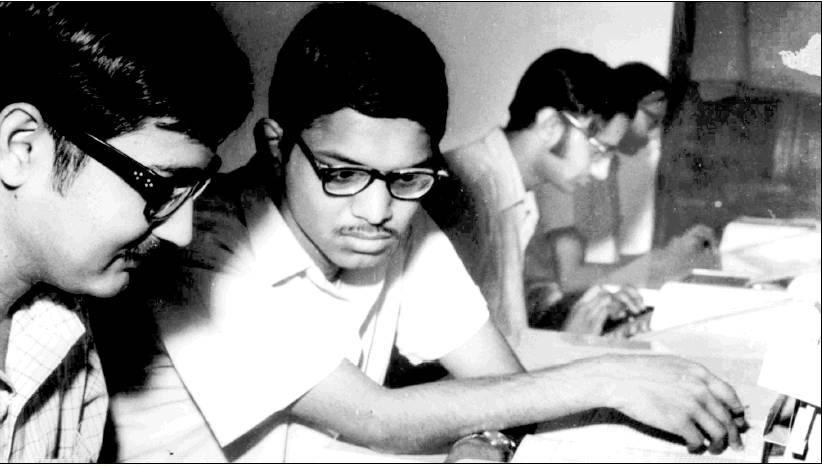
Mr. Murthy at IIM-Ahmedabad, shortly after graduating from IITK in 1969
NM: We were around 10 to 12 students who got their degrees in EE with specializations in CS from IITK in 1969. Each of us got 3 or 4 jobs as programmers. There were job offers from many companies including TELCO, TISCO, Air India, and HMT. I was somewhat lazy. I had not accepted any job offer for several weeks.
One day, Prof. Rajaraman suggested that I meet Prof. Krishnayya who was visiting IITK from IIM Ahmedabad (IIMA) looking for some graduate students to join the IIMA computer center. He wanted to install India’s first time-sharing system at IIMA. The Harvard and Stanford Business schools had installed similar systems. IIMA would be the first educational institution in India and the third business school in the world to install such a system. The job was very exciting, but the salary was half of what was being offered by the companies from which I had already got job offers. Based on Prof Rajaraman and my father’s advice to focus on learning, rather than earning, at that stage of my career, I accepted the IIMA offer. It was the best advice I could have gotten. IIMA was probably the best institute of higher education in India at that time and continues to be so even today. In many ways, I learnt a lot at IIMA. IIMA influenced me much more as a human being than IITK.
We developed a simulator for TDC 312 on HP 2116B at IIMA. Using this simulator, we developed a BASIC interpreter based on John Kemeny’s ideas. We also developed several computer-aided training applications for teaching Finance, Production, Economics, Queuing Theory, and Inventory Management. We even developed some interactive management games. We worked 20 hours a day at IIMA and enjoyed every minute of our work. There was much learning. IIMA remains a great institution.
Spark: You travelled abroad from IIMA, got knocked around in Eastern Europe (knocked about so much that it changed your socialist approach to compassionate capitalist). What encouraged you to start a private company? What learning experiences did it provide? What was the trigger that started Infosys?
58
NM: I went to work in France from IIMA. I was a strong leftist those days. I had been brought up under Nehruvian socialism. But in Paris, I was in for a shock. There was prosperity. The trains ran on time. People were healthier. Everything was clean. There was no corruption. My belief in leftism started crumbling.
During the weekends, I attended lectures at the Sorbonne on the Left and Right philosophies. I even met George Marchais, the then head of the French Communist Party. After deep introspection, I was convinced that pursuing Leftist ideology was not the solution to remove India’s poverty. On the way back to India, while travelling through Eastern Europe, I was incarcerated for 80 hours in a room in the local railway station for simply questioning Leftist philosophies in a train conversation. That is what irretrievably converted me from being a confused leftist to being a determined compassionate capitalist.
When I came back to India, I initially started working for a non-profit think tank called Systems Research Institute. Then, I started a company called Softronics. But I had not done the assessment of the market size which is an essential step for any entrepreneur. Pretty soon, I realized that there was no market for software in India at that time since there were very few computers. I folded that company within 8 or 9 months. I then took up a job as the General Manager of the software group at Patni Computer Systems Private Limited (PCS). PCS was a software company where I learnt many valuable lessons from my smart, kind, and generous boss, Sri Ashok Patni. I also learnt about the export market. Then, I founded Infosys with six of my junior colleagues.
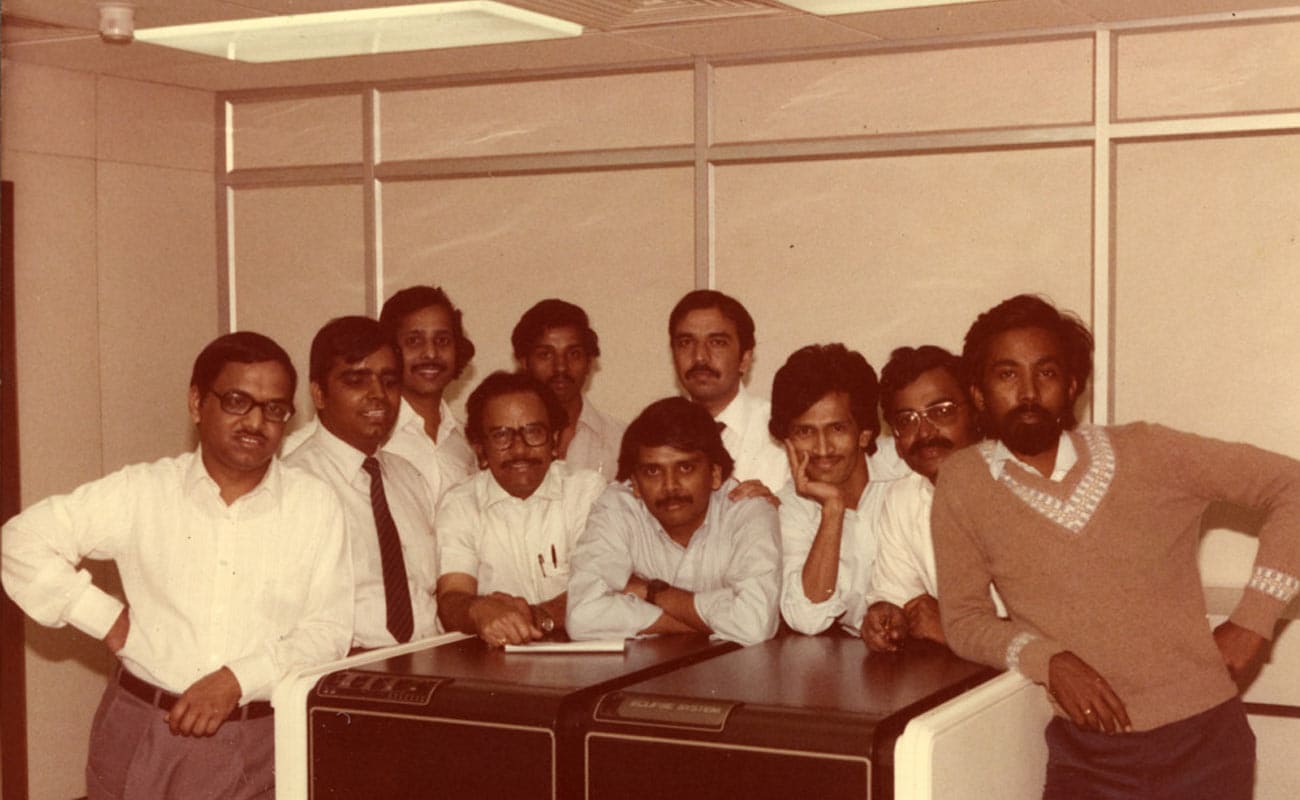
The founders of Infosys, in an image from the early 1980s. Mr. Murthy is at the very left in the group
Spark: You have said repeatedly that there was much more than revenue when measuring the success of Infosys. Please tell us about the success of the company. In your experience, have other businesses used similar principles to measure success?
NM: Infosys was founded as an experiment in entrepreneurship to create jobs, and to prove my conviction that the only way poverty could be addressed in India was by creating jobs with good income. In parallel, I wanted to create a few more firsts in the country. I wanted to create India’s first truly professional company. I borrowed the words of President Abraham Lincoln and called Infosys a company “of the professional, for the professional, and by the professional”.
Our philosophy was that everything we did at Infosys should be benchmarked with the best global standards; should use merit-oriented talent; should leverage the best technologies, systems, and processes; and be executed according to rules of good management and governance. We stipulated that no one should use corporate resources for personal benefit. We decided that we should put the interests of Infosys ahead of our personal interests in every transaction. While I was a capitalist in mind, I was a socialist at heart. I defined the concept of compassionate capitalism as early as the middle seventies and we created the country’s first large experiment in the democratization of wealth. As of today, we have given away 19% of our equity to non-founding employees, worth almost US $20 billion. No other company in India has done that.
59
We also created several global competitive advantages for Infosys through innovation in every function. While we continued to lead austere lives personally, we built a financially strong and asset-and-knowledge strong Infosys. We installed globally-best systems, technologies, and processes so that our youngsters were as productive working in India as they would be while working abroad. We wanted our youngsters to experience world class infrastructure while working in India. We did not want them to be overawed by the first world infrastructure when they reached our customer offices in an advanced country like the US.
At the end of the day, we were lucky. God was kind. You need luck. You need destiny on your side. It can come in the form of blessings from elders and good wishes from well-wishers. I would attribute a lot of whatever good has happened to Infosys to that.
Spark: We think there is one other factor that you do not mention and that is the determination part. You chose to leave IISc which was the premier institute at that time, and then went to North India where they did not speak your language, and you ate unfamiliar food. But you chose to go there anyway, following your conviction. And then, you found something that was more challenging than what you had gone for. You were determined enough to talk to your professors and make the change. After seeing what capitalism was all about, you coined your own term of Compassionate Capitalism. You founded a company based on human values and not just on commercial principles. Most people talk about these concepts. But you have made it happen. At the end of it all, is it not more than luck? Is it not a result of very solid principles and a drive to succeed?
NM: We are the product of what our parents, our teachers, our bosses, our colleagues, and our friends have taught us. Almost every principle that I adopted at Infosys was taught to me by my parents, my teachers, or my bosses. I have had friends and cohorts much smarter than I could ever be. I learnt from them. I met some extraordinary students and teachers at IITK. I have already mentioned them. I was very average by their standards. I was a little bit more adventurous than others. My parents, due to our circumstances, pushed me to be as independent as possible. They helped me to focus on doing the best I could in a situation.
At the end of the day, every one of us gets many opportunities. God gives some of us wisdom, blessings, and strength to seize one of these opportunities. That is what I define as luck. Some do not receive that wisdom, strength, and blessings. I feel that one must be lucky to have the right team and the right values. Success is about teamwork, and a set of opportunities.
Attributing things to luck also brings a little bit of humility. Humility is important in life as is faith in God. I am very comfortable with faith, I am comfortable with humility, I am comfortable with luck and God’s will. I am comfortable with acknowledging the superiority of others and my desire to learn from them, no matter what culture, religion, or region they come from.
60
Message for Institute Leadership and Current Students
Spark: Are there things you would like to see IIT Kanpur and the CSE Department address?
NM: Each generation is smarter than the previous generation. They have access to much more knowledge, information, skills, and tools than the previous generation. They have more opportunities. They learn more. They meet a larger variety of people. They hear more opinions. So, I personally feel that the quality of students at IIT Kanpur today is clearly better than those in the late sixties.
My humble request to our political leaders and bureaucrats is to help IIT Kanpur make it easy for the exchange of faculty and students with world-class educational institutions (in India and abroad) that have performed better than IITK. We need such exchange of ideas to become smarter, solve bigger problems, and gain recognition and approbation from peers. That is the only way India can be strong and prosperous. That is the only way we can redeem the dreams of our founding fathers.
Spark: Which part of your career would you like current students to emulate? What would you wish that today’s group of prospective and current IITK students use as a guiding principle as they learn and build their future?
Today’s youth live in an India which offers a lot of opportunities. The rest of the world has higher expectations from India than it had during our time. The India of today has demonstrated that if she is determined, she can achieve great things. My request to the students of today is to seize this opportunity and demonstrate that our country is second to none in fulfilling the dreams and aspirations of our founding fathers. Their dream was to ensure that the poorest child in the remotest part of the country has decent access to nutrition, health care, education, shelter, and hope for a better future, for the child itself and for his or her progeny. I think that the current generation has an extraordinary opportunity to do this. I want this generation to benchmark with the best in the world in everything and create world records in their accomplishments.
About Mr. Narayana Murthy:
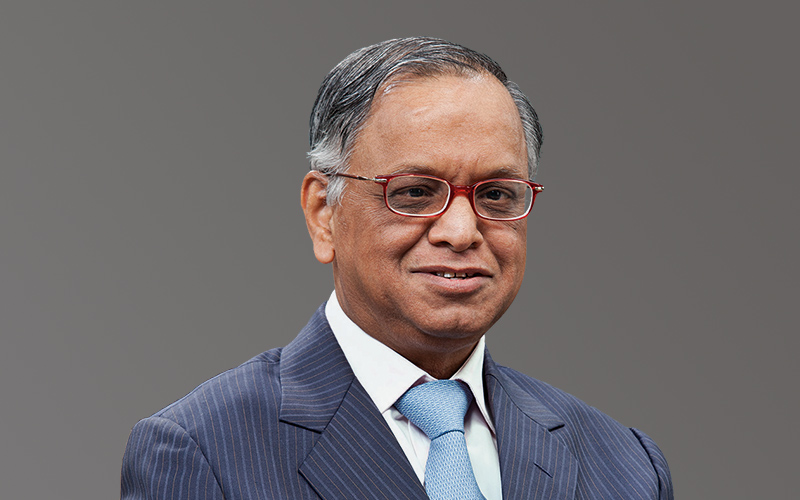
Mr. Narayana Murthy received his Bachelor’s degree in Electrical Engineering (EE) from the National Institute of Engineering, Mysore in 1967, and his Master’s degree in EE from IIT Kanpur in 1969. He was recognized as a Distinguished Alumnus of IITK in 1998.
In 1981, Mr. Murthy founded Infosys Limited, the first Indian company to be listed on the NASDAQ stock exchange. Under his leadership, Infosys became the leader in innovation - in technical, managerial and leadership training, software technology, quality, productivity, customer focus, employee satisfaction, and physical and technological infrastructure. By December 2021, the company had 260,000 employees and a market capitalization of US $95B.
In 2014, Mr. Murthy was ranked 13th among CNBC’s 25 global business leaders and in 2012 he was listed among the ‘12 greatest entrepreneurs of our time’, by Fortune magazine. He has received the Legion d’honneur from France, the CBE from Britain, and the Padma Vibhushan from India. The Economist ranked him among the 10 most-admired global business leaders in 2005. He was ranked among the top 10 in the Financial Times’ list of “Business pioneers in technology”, published in March 2015.
61
He was elected as a member of the prestigious American Academy of Arts and Sciences in 2019. He is a foreign member of the US National Academy of Engineering and a Fellow of the Indian National Academy of Engineering. He received the Founders Medal in 2018, the Hoover Medal in 2012 and the Ernst Weber Medal in 2007, all three from IEEE. He has received the Thomas Jefferson Medal and the James C. Morgan Global Humanitarian Award.
Currently, Mr. Murthy serves on the boards of the Institute for Advanced Study at Princeton, New Jersey, and the United Nations Foundation. He has served on the boards of Ford Foundation in New York, HSBC, and Unilever in London. He is a member of the advisory board of the University of Tokyo (Japan), ESSEC Business School (France), IESE Business School (Spain) and Fundação Dom Cabral (FDC – Brazil). He is also a member of the Board of Governors and Trustees of the Asian Institute of Management, Manila.
He has served as a member of the boards of several well-known universities, including Cornell University, the Wharton School at University of Pennsylvania, the Graduate School of Business at Stanford University, and the Rhodes Trust at Oxford. He was the Chairman of the Indian Institute of Management (Ahmedabad), and the Public Health Foundation of India (PHFI). He has also served on the international advisory boards of Yale University, University of Illinois at Urbana-Champaign, William F. Achtmeyer Center for Global Leadership at the Tuck School of Business, Singapore Management University, INSEAD (France), Asian Institute of Technology (Bangkok), the Indian School of Business (Hyderabad), and the International Institute of Information Technology, Bangalore.
In keeping with his philosophies, and his goals for making education available to India’s masses, Mr. Murthy has become the largest benefactor in IIT Kanpur’s history. While his most visible donations have funded the H.R. Kadim Diwan Building (the home to the CSE Department), on an ongoing basis, his donations provide yearly support to 17 Academic Departments and five Interdisciplinary programmes. They have supported chair professorships, grants for new faculty, fellowships for PhD students, travel grants for national and international conferences, awards for student publications, and endowments for teaching excellence. The funds have supported maintenance of the CSE building, upgrades of student messes, construction of visiting faculty apartments, and new labs for earthquake engineering.
Thank you, Mr. Murthy, for your support to the Institute, and for being an inspiration to us all!
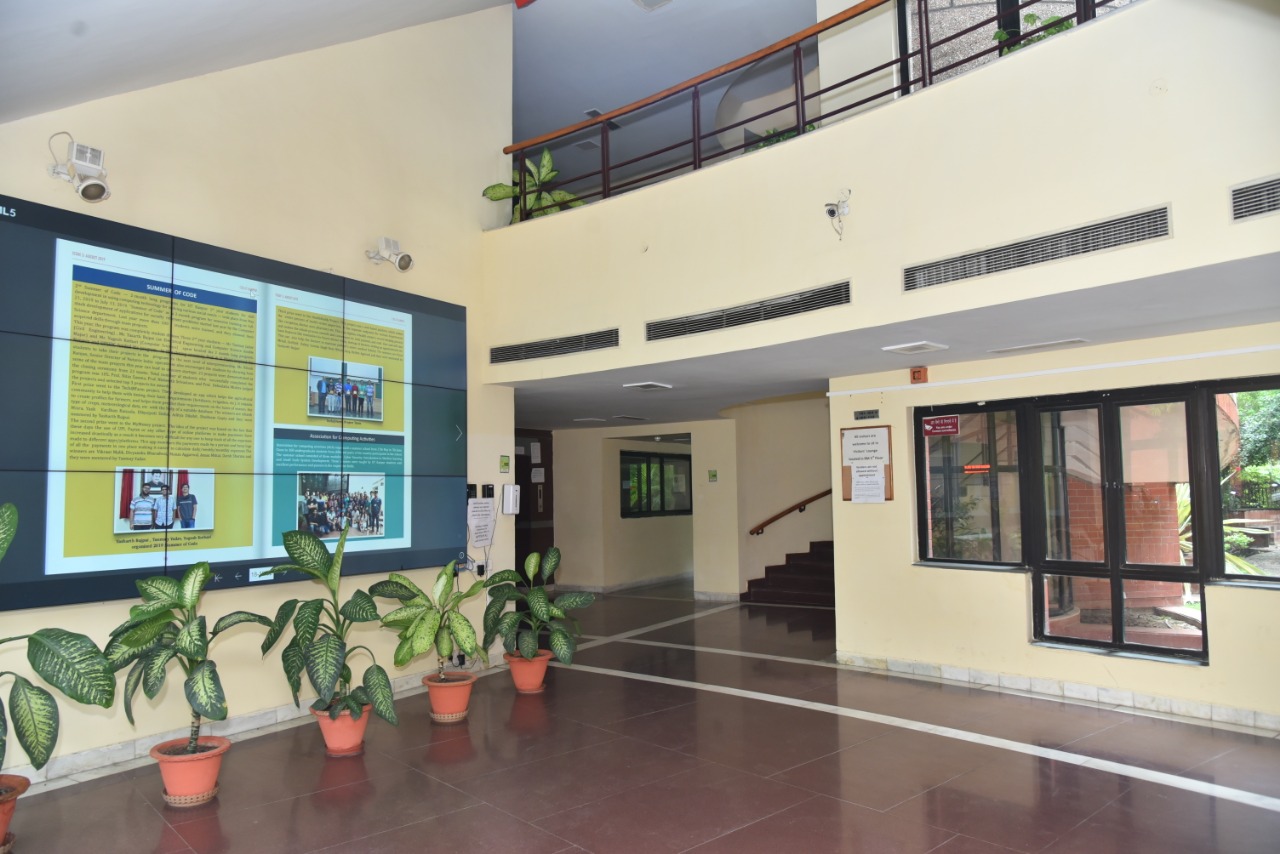
The H.R. Kadim Diwan Building, IITK, September 2021
62
Time Travelling the Library Fountain
Aseem Shukla (BT, ChE, 1978-83)
The library wasn’t always air-conditioned, and the pond did not always have a fountain. In fact, in the earliest days there was a tree in the middle of the pond, as seen in some of the pictures below. To keep the air circulating the library windows were kept open in those days, but this in turn led to dust accumulating on the books. Then, in the late sixties, the fountains were added, the library became the coolest spot on the campus, and the legends of the sleepover parties grew.
The remarkable design of the air-conditioning system was a source of much pride, not just for its aesthetic appeal, but also for its unique heat transfer mechanisms. To the grief of students, it also became the source of problems on the Fluid/HMT end-semester exams, particularly one by Prof SK Gupta (ChE) that was confronted by several batches in the 1980s and 90s.
The fountain was functional till at least 2010. Then, after another breakdown signaled an end to its useful life, a more efficient air-conditioning system was installed in the library. The jets and their supporting blocks stood around for a few more years before being finally removed in 2019. But even in its dismantled state, the fountain continued to inspire creative photography, as seen from the many postings in our group.
Now with the transition to the new fountain garden complete, we look forward to the next generation of iconic images that will follow!
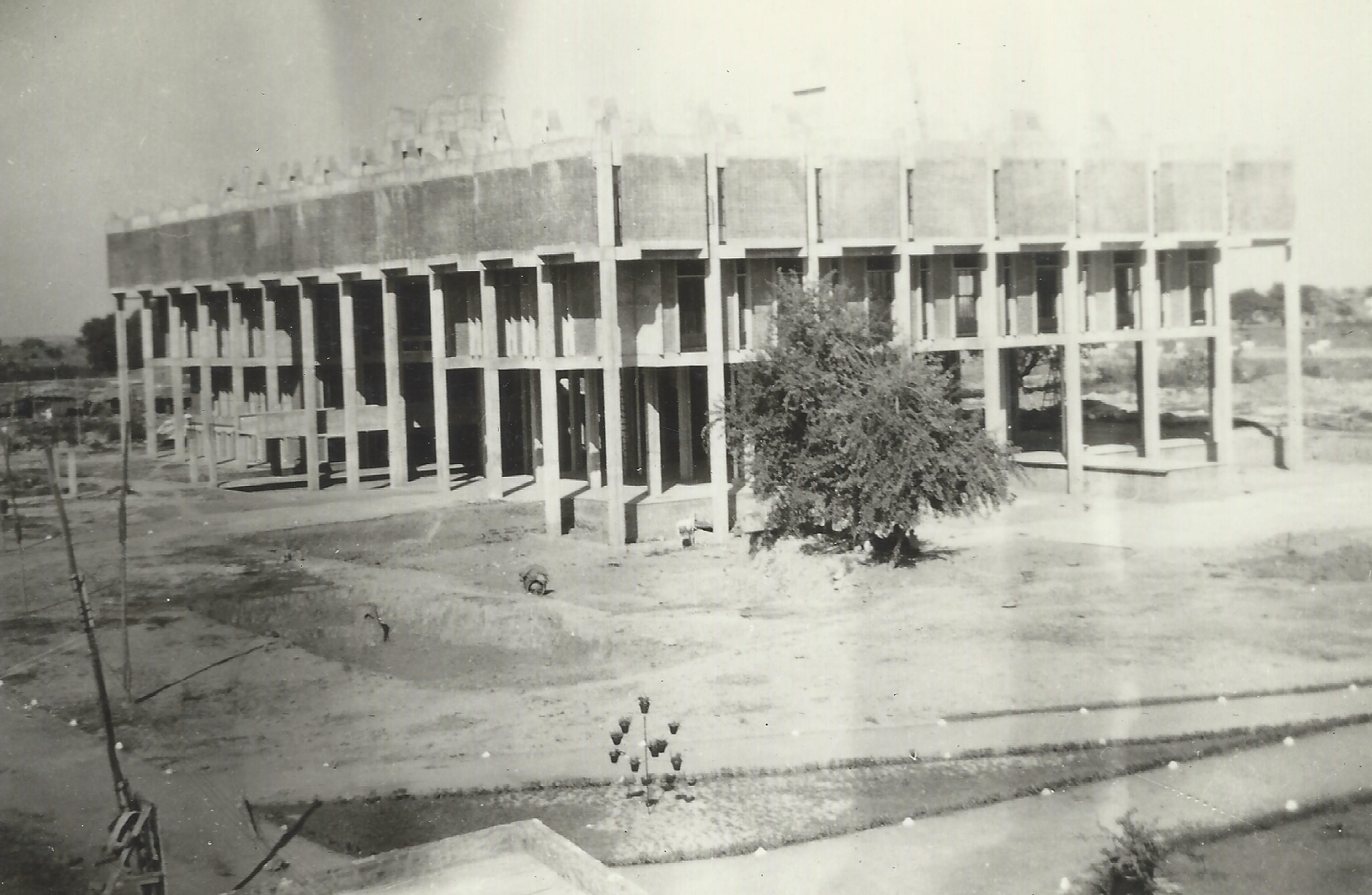
Picture Credit: Sri Gupta (BT, AE, 1962-67), clicked circa 1965
63
A very early picture from 1965 shows a nearly complete library with the walkways still under construction. The cooling pond area was a large pit that was used to cast the concrete blocks that now line the sidewalks along all the campus roads.
Notice the tree in the middle of the ‘pond’. Trees around the library had a very special significance and were not removed during the construction process. So, a circular retaining wall was built around the tree to protect its roots from the pond water. Another tree on the East (Shop C) side of the library, and barely visible through the library columns, had a more intriguing story. Since it stood in the path of the walkway heading to Southern Labs, the site map of the entire academic area was shifted southwards by 30 feet in order to save it, leaving behind the kink in the Main Drive at the (old) SAC – Shop C intersection. That, of course, is another story!

Picture credit: Gyan Mehta (MSc Physics, 1968), clicked Sept 1967.
This brilliant color photograph, clicked on Kodachrome slide film from 1967, shows the completed pond with the carefully protected tree at its center. There were no fountains, and the Library was not air-conditioned, that was to come a few years later.
64
The tree survived a few more years but was gone by the early 1970s. Perhaps the continuous rain showers from the fountains were too much for its roots to handle. The circular bit of soil was then covered with a concrete platform, which provided its own version of a dance floor for those seeking thrills while posing for photographs between the raining fountains!
The fountains became operational around 1970 and kept the Library cool for the next 40 years. The Library itself became famous as the coolest place on the campus. In the summers, especially during the Summer Semesters, people would sneak in, hide behind the bookshelves at closing time, and spend nights in slumber party sleepovers.
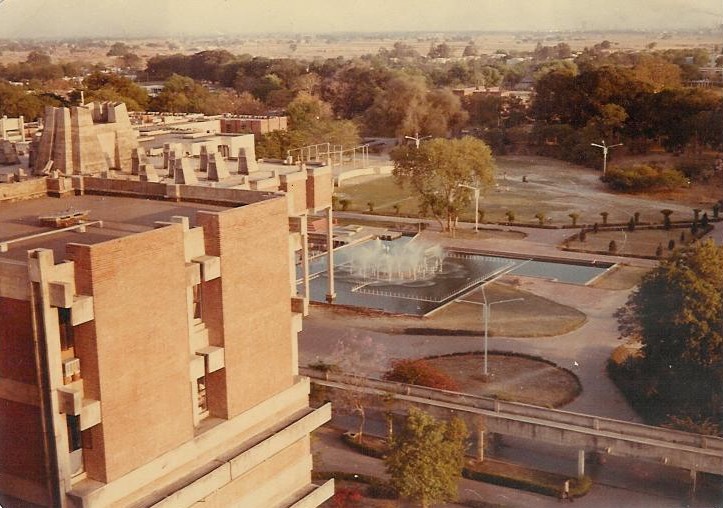
Picture Credit: Parikh Mani Baro (BT, MME, 1977-82), clicked circa 1981
Some images on the campus have been clicked over and over again. This view from the ‘batman ears’ on the top of the FB water tank is one of them. To get here was not easy. You had to take the staircase to the Sixth floor, then go up the metal ladder to the glass windows to get to the roof, and finally climb those rusted metal brackets on the tank itself. The pond was visible over the edge, but it took a little extra courage to get the picture. Without selfie sticks and super long zooms there was only so far you could stretch, without toppling over. But it was done, and quite a few times actually – we have seen several identical clicks, between 1976 and 2010, with the head of the eagle, and its right wing visible. Only the trees get taller with time!
The Head of the Eagle? The unusual shape of the pool led to much speculation and was the subject of many conspiracy theories. A few students were usually introduced to the secret by seniors during ragging time, and the legend passed on… it was an American Bald Eagle, a little souvenir left behind by the KIAP team to remember their involvement in the construction of the campus.
65
For those not familiar with the history of IITK, the land for the campus was donated by the Singhania family, the buildings were designed by Achyut Kavinde (of the architectural firm of Kanvinde, Rai and Chowdhury), and funds for their construction were provided by the Government of India. The KIAP team provided the program management, initially for construction, then for operations, and finally intellectual know-how and course design… the lab equipment, books for the library, and of course the experience and knowledge of the American faculty.
Thus, nothing could have been constructed without the knowledge and approval of the Indian leadership. But construction of the site was overseen by Mr. Jerry Vielehr, who spent more than seven years on campus (1962-69) making sure everything came up as planned and on schedule, (he later went on to become the CEO of a major Milwaukee brewing company in the 1970s), and he could well have provided that suggestion.

Picture Credit: Shirish Joshi (BT, ChE, 1973-78), clicked circa 1977
Over the past 30 or 40 years, many people have questioned whether the fountain in front of the library was really in the shape of an American Eagle. And if so, where were the head, wings, tail, and other body parts. So, we used our limited skills to draw the outline of the eagle with a yellow line and label the relevant parts. Now that the original fountain has been replaced with a new Fountain Garden, it will be interesting to know if that shape has been retained. A trip to the appropriate library window, or preferably, the roof will provide the answer.
66
There actually were two sets of fountains, one in each ‘wing’ of the eagle. Typically, one would be sufficient to keep the library cool, and the other would serve as a backup with downtime available for maintenance and servicing.
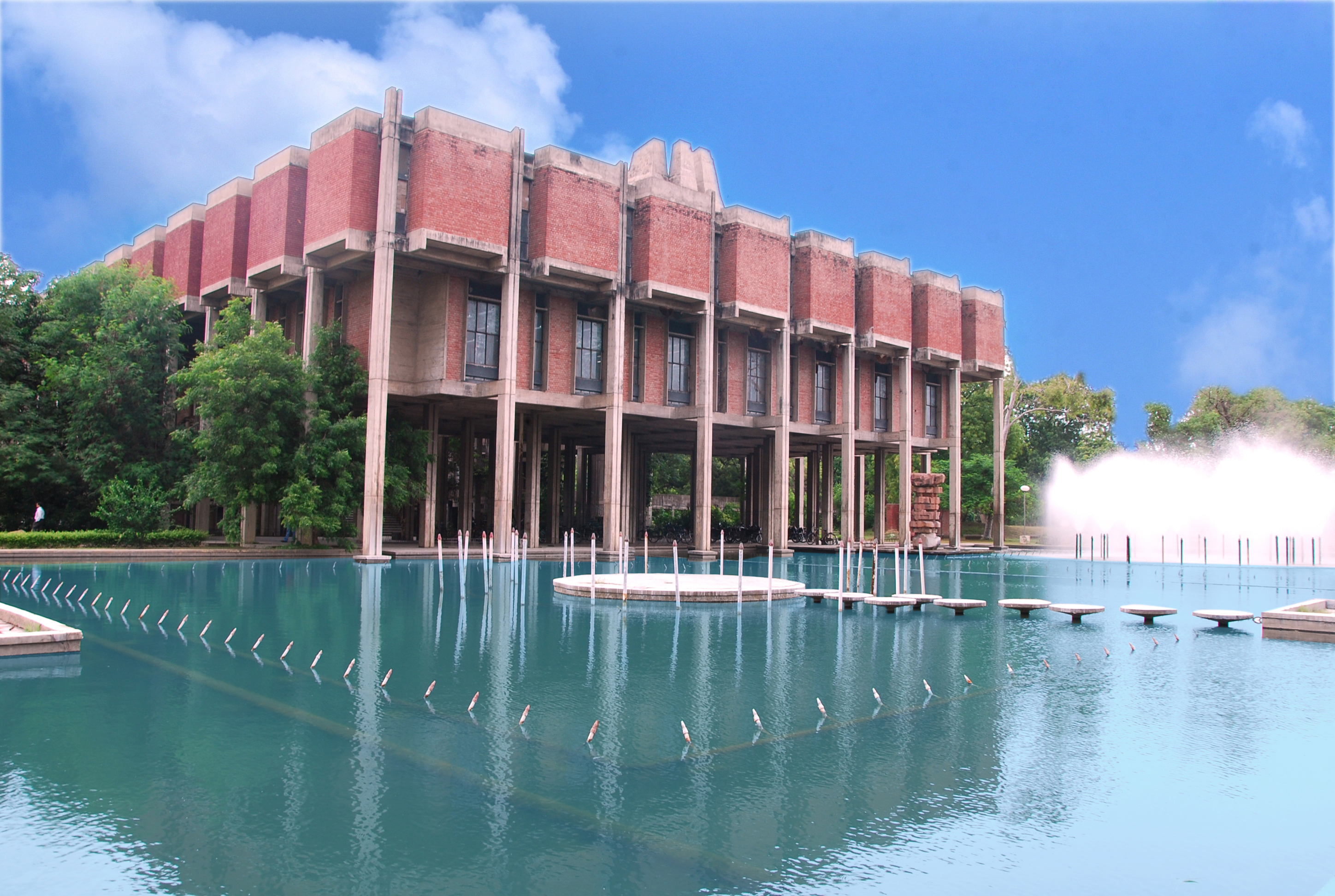
The iconic image of the front fountains became the face of IITK on institute brochures from the 1970s through the 2010s. This image is of the rear fountains, circa 2005, and has been shared by Girish Pant (Information Cell, IITK)
In 1998, a ‘boat race’ was part of the third design course in Mechanical Engineering. Students designed and built model boats powered by small steam engines, then raced them for glory (grades). That year, the boat race was held in the cooling pond in front of the P.K. Kelkar Library. The race had just begun; the judges were strutting back and forth with their sheaves of scoring sheets, when pandemonium broke loose. In the heat of the moment, everybody had forgotten the large beehives that hung from the concrete sunshades of the library. The fumes from the kerosene-burning steam engines had agitated the bees and they swooped down on the assemblage of contestants and spectators. Students ran leaving their boats, the judges their score sheets, and the instructor of the course just ran away. In more ways than one, this event was a first. Never before had an IITK exam ended in such chaos!
Professor Barun Banerjee (Faculty, ME, 1977-2009)
And per the relative grading guidelines of IITK, we believe that the whole class was given Bees!
67
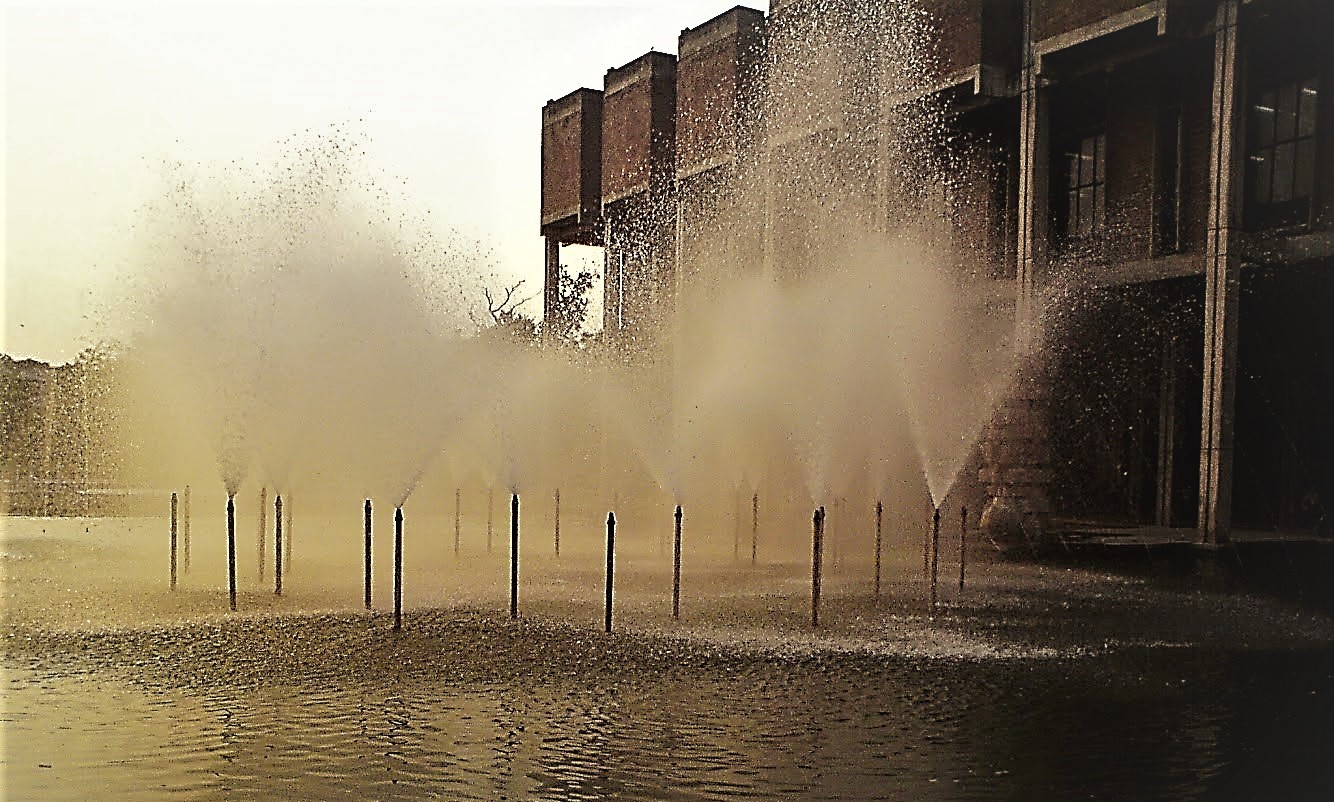
Picture Credit: Pranay Mehta (BT/MT, ChE, 2009-14), clicked circa 2010
A drop of water leaves the nozzle of a library fountain and rises to a height of 2 meters. By how many degrees do 10 million drops lower the temperature of the library? Make reasonable assumptions on the required parameters including drop size, flow rates, ambient temperatures, library space, conductivity ratios, Reynolds numbers, Nusselt numbers, and any other parameters that you deem necessary. Credit will be based on the thoroughness of the problem design, relevance of the assumptions, and the solution methodology followed.
Originally written as an End-Sem problem for ESc 315 (Fluid Mech / HMT) in 1980 by Professor Santosh K. Gupta (BT, ChE, 1963-68; Faculty ChE 1973-2012; Institute Fellow 2021)
Towards the end of the semester in 1980, Dr. SKG mentioned to some of us that he had put together a little piece that ‘we could use in the Spark’. A few days later, during the End-Sem exam in L-7, we were staring at it… a page long problem that seemed to go on and on and on, testing our knowledge of every concept we had been taught during the semester. Some, with very clear fundas, ventured to solve it. Other, more mortal souls gave up after the first few steps!
All parameters of the fountain system had been carefully specified, and the problem probably had a unique solution. And though some of us held on to it for a while, realizing its value as a classic masterpiece, 40+ years later, the original has been lost and cannot be recreated. Shared here is a more generic problem, with a challenge to the current students… work on it in teams to define the problem and find a solution. A team of faculty members has offered to evaluate the responses and we will publish the best solutions in the next issue.
68
Then, with time, the fountains would fall silent. Breakdowns were becoming more frequent, and a more efficient air-conditioning system had been installed in the library. The fountains stopped functioning sometime around 2011, though the units were not actually dismantled till some years later.
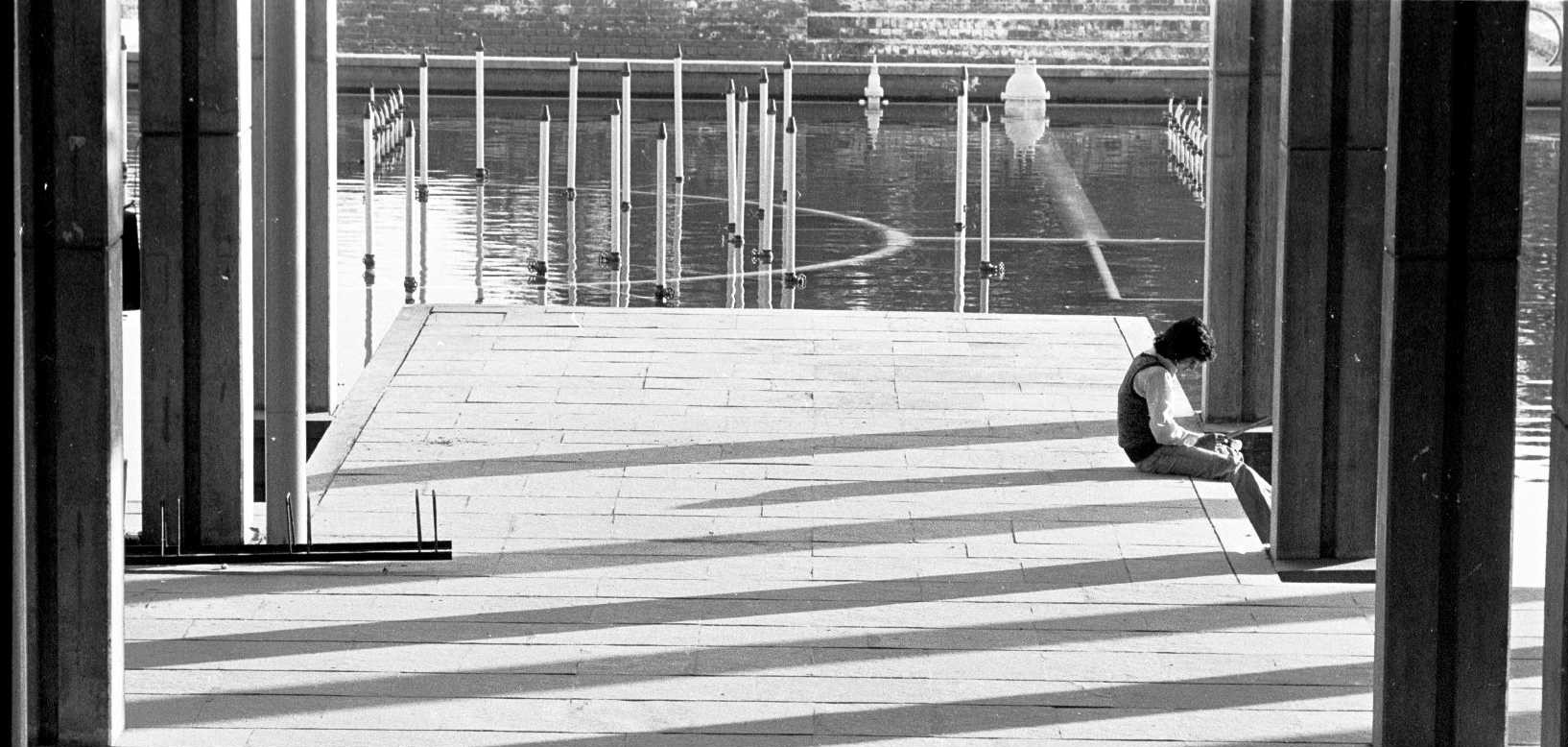
And the vision that was planted in my brain
still remains, within the sound of silence…
Picture Credit: Shirish Joshi, clicked circa 1977, model Sanjiv Seoni (1973-78). Lyrics: Paul Simon
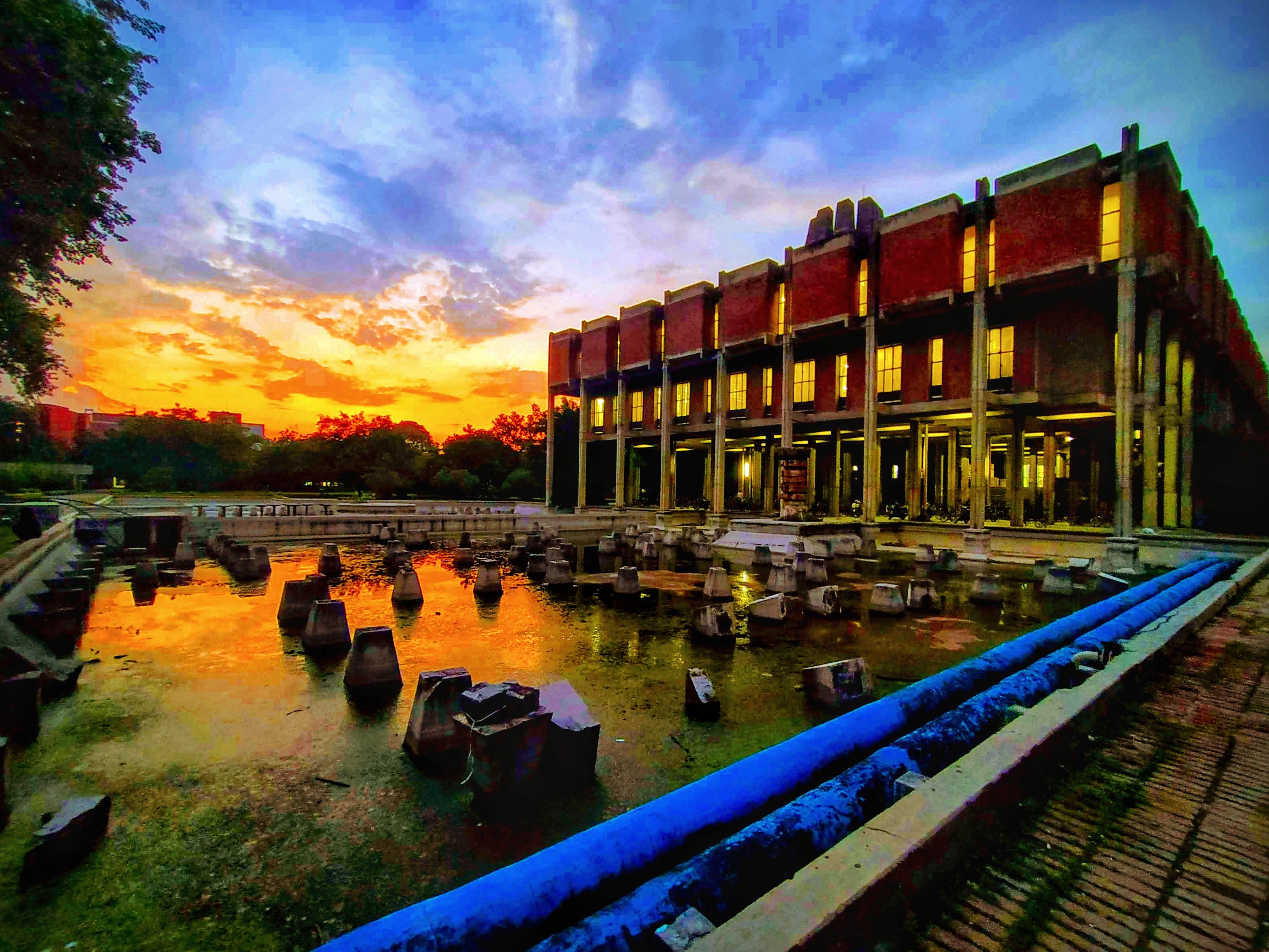
The Halloween Sunset… perhaps the last image of the old fountain taken before the renovations
Picture Credit: Himanshu Singh Gehlot (MT, Earth Sciences, 2018-20), clicked Oct 2019
69
On November 1, 2021, after more than a year of COVID related delays, the fountains came back to life, in time for the Institute Foundation Day and the Diwali celebrations. Here are images of how they look today.
We would love to see more pictures and invite you to share them with us!

Picture Credit: Shakti Chaturvedi (MBA, IME, 2014-16, presently Research Scholar IME)

View of L-20 from the Library Fountain Garden. Southern Labs are visible on the left behind the fountains.
Picture Credit: Animesh Singh (BT, CE, 2019-23)
70

Picture Credit: Himadri Roy (Research Scholar, Physics)
Credits:
Text written by Aseem Shukla (BT, ChE, 1978-83)
The pictures shared in this story were taken from postings in the Facebook group This Bit of That IITK. Created over three years ago, this group has grown to 4,000 members and probably has the largest collection of current and historical IITK pictures, memorabilia, and anecdotes anywhere.
We welcome new members and would love for you to join the group. We welcome current IITK students, alumni, faculty, ex-faculty, administration and staff, and all others with valid IITK connections, and we do ask that you respond to the three screening questions so that we can validate your membership.
Cover Pictures:
Front Cover: The fountains as seen between 1969 and 2010, shared by Girish Pant (Information Cell, IITK); the view from November 2021 clicked by Shakti Chaturvedi (MBA, IME, 2014-16, presently Research Scholar IME)
Back Cover: The Pre-Covid look, picture and sketch by Krishnendu Paul (Research Scholar, Earth Science)
Cover Design by Outreach Cell, IITK
71
